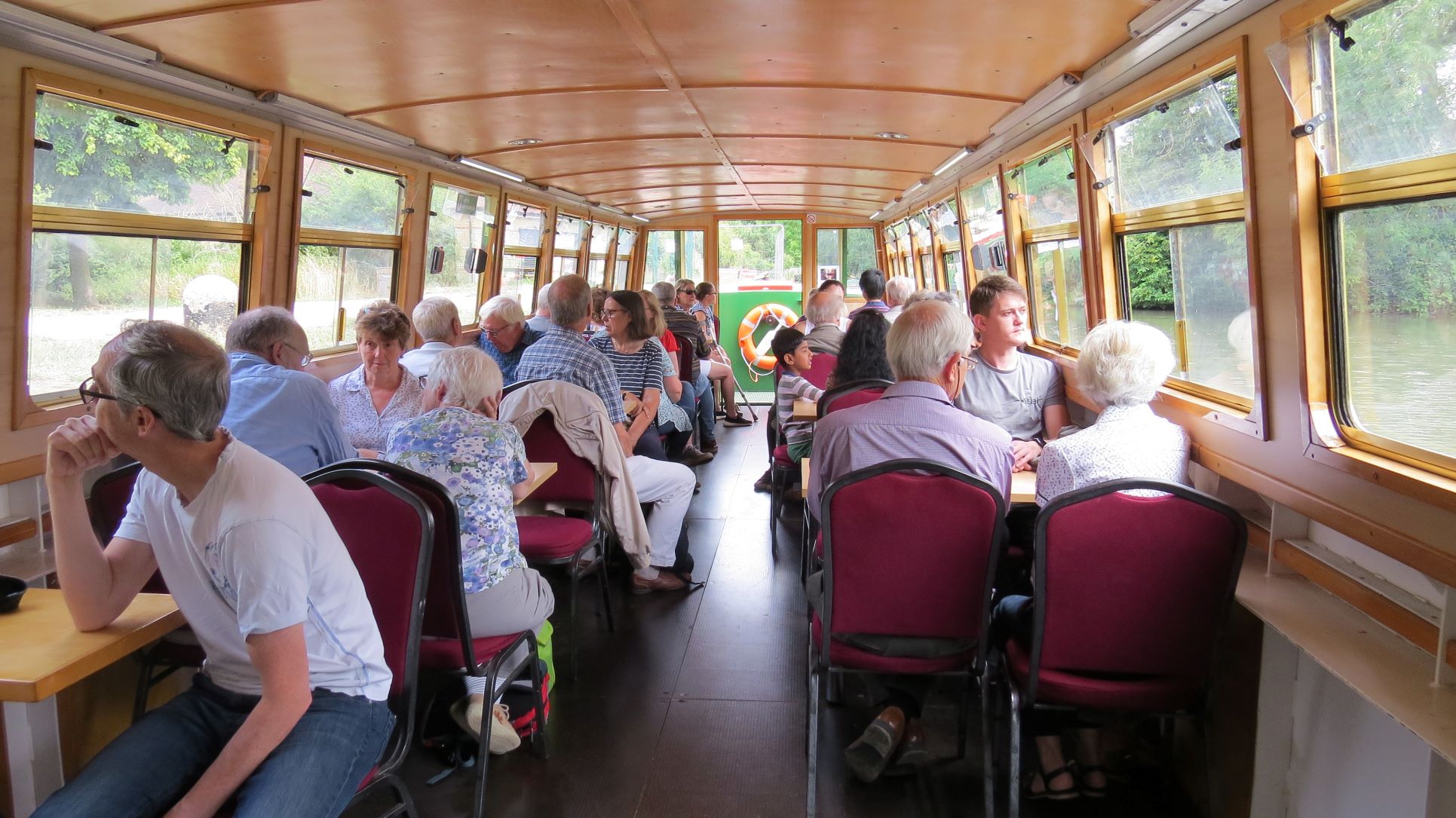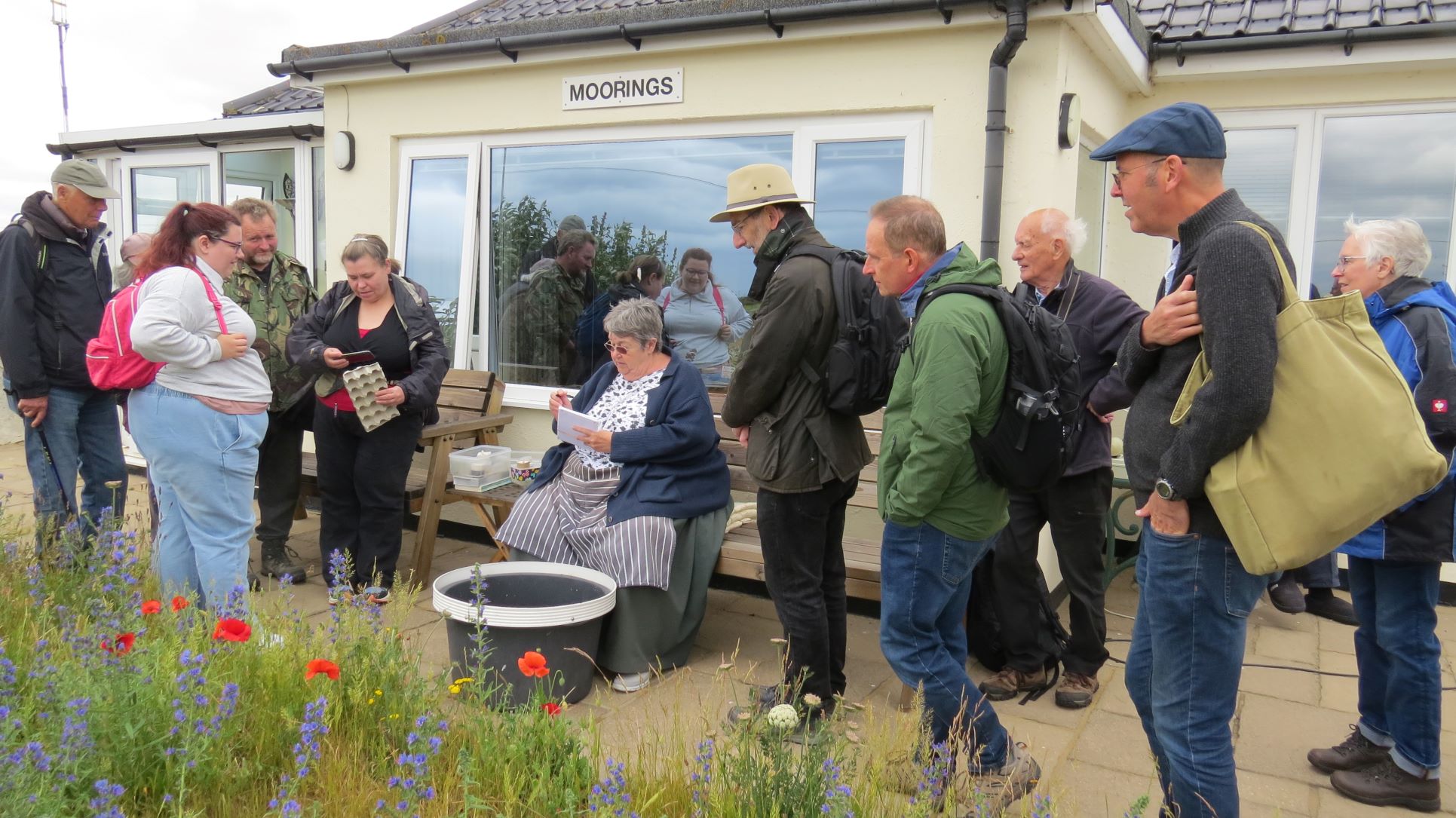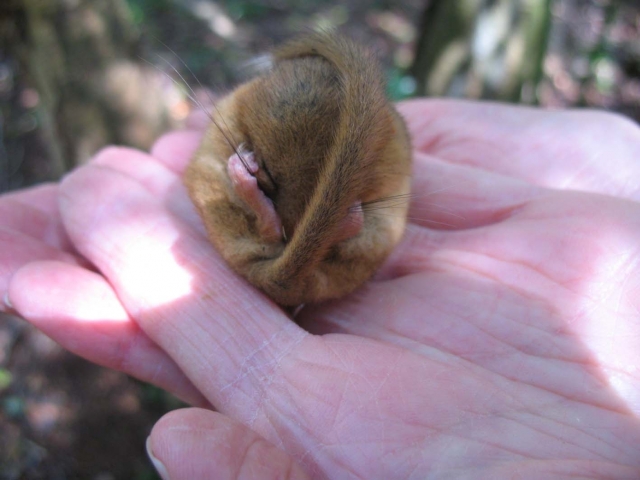Reports
Dr Graham Godfrey FRSB, 1935-2023
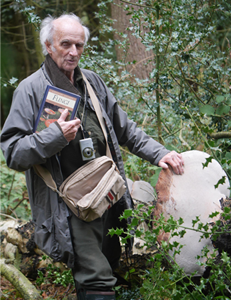
Dr Graham Godfrey passed away in December 2024 at the age of 88. Graham was a lifetime member of the RSB, indeed he was a founding member of the Kent, Surrey and Sussex branch half a century ago and prior to that belonged to the London branch. Graham's service stretches back to the Institute of Biology, through the Society of Biology to the current Royal Society of Biology. He was an active supporter of the RSB, in particular the KS&S branch and had previously served as Chairman of the branch committee for several years. He was awarded the President's Medal in 2008.
Graham was born in Birmingham, attending King Edward's grammar school. His first degree was an external degree, awarded by the University of London. He followed this with a PhD at The Middlesex Hospital and a teaching qualification at Canterbury. By this time he was Kent based and took a post at Medway College where he taught for over 30 years.
Graham's interest in biology never waned, he was well read in a wide range of biological topics. He took a particular interest in the events the branch committee held at schools and colleges - he was keen to promote biology as a career and initiated connections between the RSB and a number of schools and colleges.
Graham was a mainstay of the KS&S branch AGM over many years, putting forward interesting speakers and organising venues, ably assisted by his wife Audrey on the catering front. Many members attending AGMs will remember his interest in wine and the knowledge he had accrued from his travels in France and Italy. Graham also had an interest in photography and often captured the images that were used alongside KS&S reports in The Biologist. He was a unique character and will be greatly missed in so many ways by the KS&S committee and the wider membership.
Graham was married to Audrey and our thoughts are with her, their three children and families.
The Kent, Surrey and Sussex branch committee
Visit to the British Wildlife Centre, Lingfield, Surrey
The British Wildlife Centre was founded in 1997 by David Mills, a dairy farmer who converted his farm into a 'zoo' containing British native wildlife.
We had the Centre to ourselves during our private tour, which was led by a knowledgeable and enthusiastic guide. Among the animals were three species of owl - Little Owl, Tawny Owl and Eagle Owl- as well as a Buzzard. The owls are semi-wild in that they are sometimes released, only to return within a day or two to their enclosures. They seem to know when they are onto a good thing!
Some of the animals were acquired because they would not fare well in the wild, such as foxes that had become too friendly. The foxes have plenty of space to roam in, and seemed comfortable to be admired by our group.
Other species included stoats, weasels, polecats and pine martens, and we learnt about ongoing successful efforts to conserve the latter species in Britain. We were able to see nocturnal species - badgers and hedgehogs- in the dark enclosure; these animals had room to roam and feed during the night. We were also able to get 'up close and personal' to otters and Scottish Wildcats - the first time many of us had ever seen them.
In addition to an area of land given over to several species of deer, part of the former farmland has been converted into a nature reserve, and includes a large pond containing fish and water birds. Animals spotted on the reserve include water voles, harvest mice, tree creeper, osprey, bearded tit, redwing and little egret.
The Centre's motto is 'Conservation through education' and it serves its purpose well. Certainly, our group of a couple of dozen people, ranging from students to experienced biologists, thoroughly enjoyed our visit.
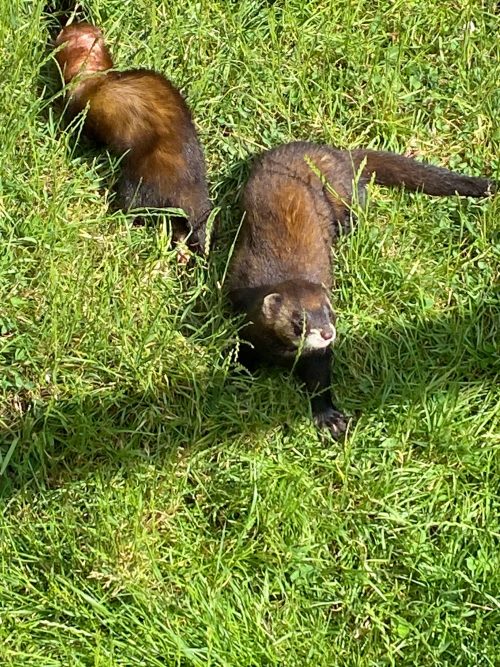
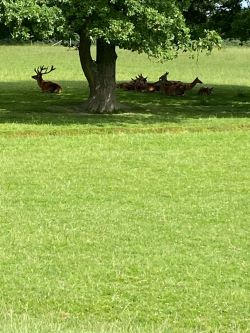
Photo credit: Dafydd Lewis FRSB
Dafydd Lewis FRSB
Visit to The World Garden at Lullingstone Castle
On Saturday 17th June, we took a private tour of The World Garden lead by renowned horticulturalist Tom Hart-Dyke, who is an engaging speaker with an excellent knowledge of plants. We had a full tour of the gardens at Lullingstone Castle, including the World Garden which was set out to highlight plants according to specific countries of the world.
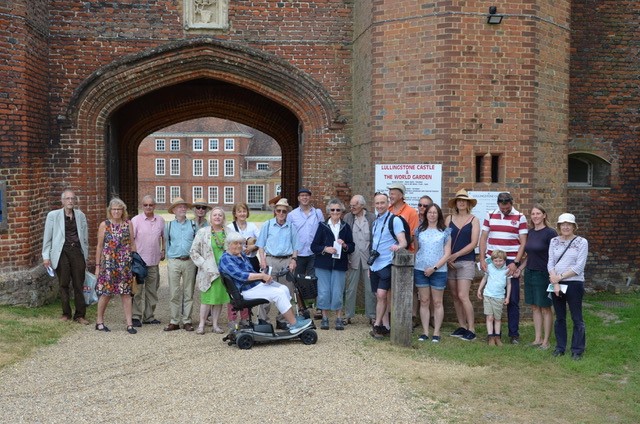
It was interesting to see the effects of the harsh, cold snap last winter. Some plants are flowering like never before, while others like the National Collection of Eucalypts that is held at Lullingstone, suffered from the cold. It turned out to be quite a sensory tour with the flowering dracunculus vulgaris, known as the dragon arum, that produces the smell of rotting meat, and the flowers of the dictamnus albus, or burning bush, with its volatile oils. A final highlight was the plant sale and refreshment tent.
Sophy Denny MRSB
Basingstoke Canal Visit
The Basingstoke Canal was built in the late 18th century to connect Basingstoke with the River Thames at Weybridge, primarily to stimulate farming in Hampshire and provide for the easy transport or agriculture produce to London. However, it was never a commercial success and its declining use and lack of maintenance led to it becoming derelict by the mid 1950s.
In 1966, a group of volunteers formed The Basingstoke Canal Society to save the privately-owned waterway and campaign for its restoration under public ownership. In the early 1970s Hampshire and Surrey County Councils purchased the Canal. Then, in 1991, after 20 years of hard work, 32 miles of the Canal were formally reopened to navigation
The Canal supports a great diversity of riparian flora and fauna and is considered the most biodiverse freshwater body in England and Wales, with 90% of its length designated as an SSSI.
The geographical location of the Canal provided an ideal opportunity for a joint visit by the Kent, Surrey and Sussex, Thames Valley and Wessex Branches. Therefore, members from these branches were able to meet up with members from their own and other branches as they took a trip along a section of the Canal near Odiham in Hampshire in the John Pinkerton II canal boat, skillfully operated by volunteer members of the Basingstoke Canal Society. At the same time they were able to view and enjoy this special habitat and the members of its flora and fauna that put in an appearance at the time Local expert, Mr Roger Cansdale, provided commentary to the group on the history of the Canal and aspects of its biology, as well as providing them with the opportunity to tap into his specialist knowledge of the Canal as he mingled with them afterwards.
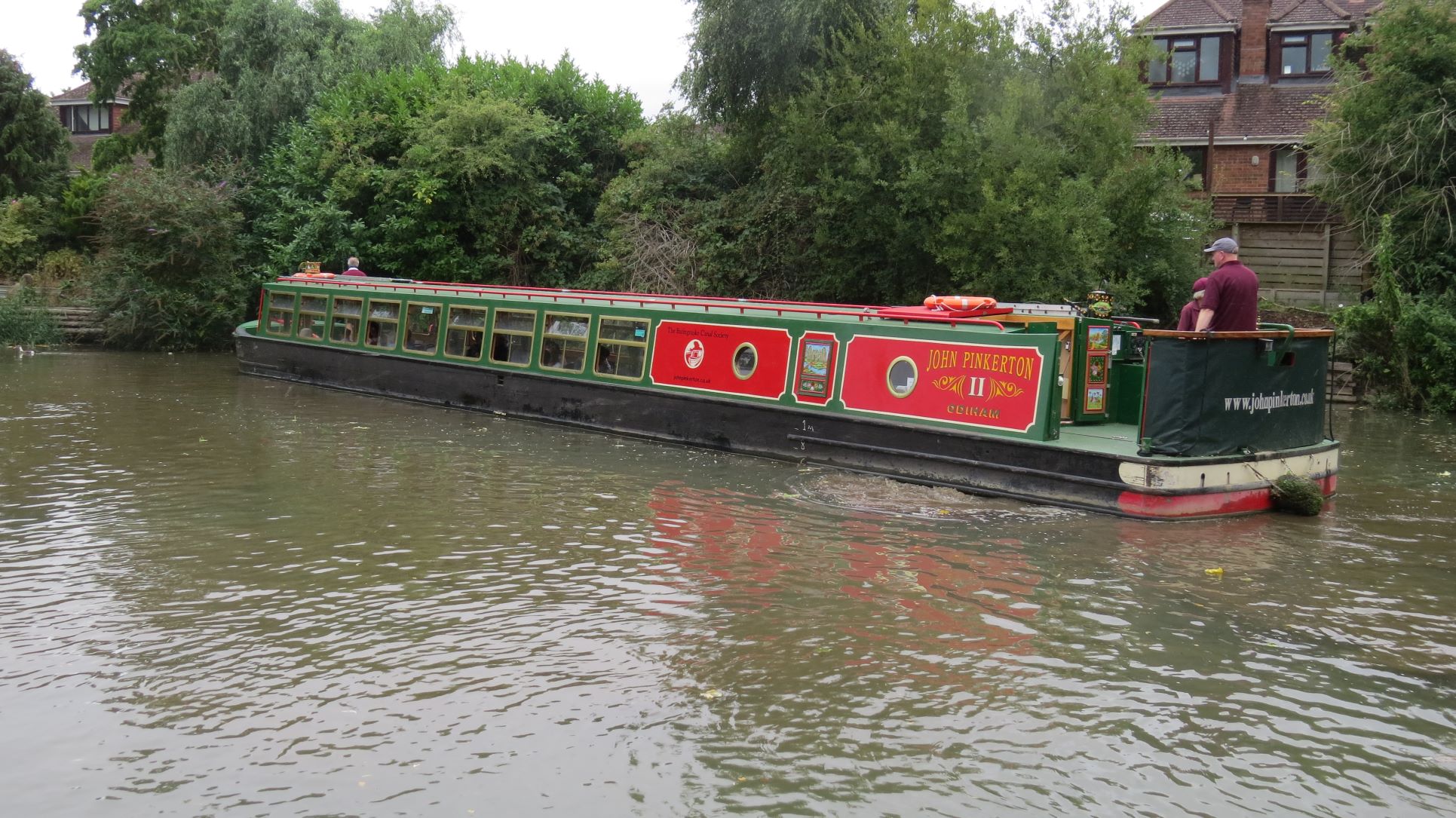
Photo credit: Dr Graham Godfrey CBiol FRSB
Dr Ralph Manly FRSB
A Botanical Exploration of the Dungeness Shingle
Sunday 19th June 2022
Dungeness is a cuspate foreland of Kent that comprises the largest shingle beach in Europe. It consists of hundreds of ridges which have accumulated since the late Holocene by dominant south west waves causing long-shore drift from west to east, thus eroding the south-west side of Dungeness accompanied by accretion on the east side.
A record of the movement and sediment accretion is preserved by the shingle beach ridges, which provide a unique succession of plants, and is a rare haven of animal and plant species. On the day of our visit to this site, we had as our guide Dr Brian Ferry, Royal Holloway, University of London, who is an acknowledged expert on the vegetation growing on shingle habitats.
Before we commenced our botanical studies, however, we paid a visit to local moth-traps on the shingle. Here Dorothy Beck, Dr Ferry's colleague, showed us the previous night's catch, which yielded a rich collection including the Sussex emerald, Thaleria fimbrialis, a threatened species only breeding at Dungeness, and even two hawk moths, Deilephila elpenor and Sphinx ligustri.
Moving on to the plant succession, the first to colonise the shingle above the tidemark is the ephemeral annual Babington's orache, Atriplex glabruscula, which obtains its minerals from rotting seaweed. Indeed, the subsequent succession of plants occurring as we worked inland across successive ridges is dependent upon the increasing accumulation of organic material in the shingle. We thus recorded the succession of species characteristics of this changing enviroment, including such rarities as shepherd's cress, Teesdalia radicaulis, Sheep's bit, Jasione montana, and Nottingham catchfly, Silene nutans. For those interested in this unique and fascinating environment, fuller details including species lists may be found on the KSS branch web pages.
If you would like to learn more about the vegetation occurring at Dungeness, please download this PDF.
Dr Graham Godfrey CBiol FRSB
The Fascinating World of Cannabis Biology and Pharmacology
Thursday 21 October 2021
David Potter, Director of Botanical Research at GW Pharmaceuticals gave an interesting presentation on the Biology of the cannabis plant (Cannabis sativa) and its ancient and modern legitimate uses. This plant has been used by man for 8000 years. The fibres of the hemp stem were used to make ropes and rigging for ships. It was used as a medicine in the Victorian era. Interest in the use of cannabis as a medicine declined in the 20th century until the late 1990s.
Dr Potter explained the taxonomy of the plant. He believes there is only one species, Cannabis sativa, but not everyone agrees with this. Any cannabis plant from anywhere in the world can breed with another plant to produce fertile offspring. The plant may produce tetrahydrocannabinol (THC) which is psychoactive or cannabidiol (CBD) which is anti-psychotic and genes determine which substance is produced. There are two sets of cannabinoid receptors in the human body which respond to the drug.
The plants can be male or female and be grown from seeds or cuttings and it is possible to tell which the plant is grown from by the morphology of the plant. The females are more resistant to attack by aphids. The resin containing the active substance is present on the trichomes which cover the flowers and some small leaves.
The potency of cannabis in the UK has doubled over 10 years and this is a major cause of psychosis. The bulk of cannabis seizures by police are now home-grown material rather than resin. Most plants used to contain both CBD and THC at an equal ratio, however, now most contain a much higher ratio of THC, and as a result cannabis is becoming more dangerous.
Alison Livesey MRSB
Something in the Air
Wednesday 18 August 2021
We were delighted to welcome Professor Lidia Morawska, an acknowledged and eminent expert on particulate airborne transmission, and whose research has revolutionised the understanding of the spread of disease from person- to- person. The outcome of her and others’ work has resulted in the World Health Organisation (WHO), after much resistance, slowly changing its advice on the mode of viral transmission.
Watch Lidia's talk on the RSB YouTube channel
Lidia explained how the atomisation of particles in the respiratory tract occurs as a result of airstreams passing over a liquid surface at speed, and bathing the larynx and vocal cords, whose vibration produces, with saliva, an aerosol in the mouth, carrying particles originating from bubble collapse in the bronchioles to the alveoli before subsequent exhalation.
The size distribution from a bronchial burst ranges from 0.1-1000 µm, and those from 0.1-10 µm remain suspended longest in the air. Most of those expelled in coughing and breathing rang in size from 0.1-0.4 µm. The naked SARS-CoV-2 virus measures about 0.12 µm, but is carried in the air as a blob of mucus, water and salts of greater diameter, and particles less than 1.0 µm carry the highest viral load which can remain suspended in the air for a considerable time.
Vocalisation produces higher emission than other activities, and most of virus-laden particles are less than 1µm, with the vast majority being less than 10 µm. Smaller particles carry higher viral loads, and come from deeper in the respiratory tract where the virus is located. The water in the droplets evaporates quickly to 20-40% of its original volume, so we are measuring the droplet nucleus. In comparing falling time of droplets in air, it ranges from 0.3 seconds to 300 seconds for 1000 to 10µm particles respectively, and for 1 µm aerosol particles it takes 30,000 seconds, so that in effect they remain in the air to be inhaled.
Regarding the fate of inhaled particles, those from sub-1 µm to 10 µm are deposited in the head airways and lungs, which is the worst scenario, though anatomical variations and breathing patterns between individuals affect deposition. In the absence of efficient ventilation, indoors infection is caused by long-range airborne transmission. Ventilation of about ten air changes per hour results in considerable reduction in risk of infection. A paradigm change in building design is needed to prevent air recirculation. The associated costs would be far outweighed by the economic benefits. Of course, said Lidia, local authorities will still ignore the evidence, and stick to the old medical dogmas. It is a tragedy that the medical profession and the WHO haven’t even now fully grasped the science, and have relied on outdated received wisdom for their advice, including “Wear a mask, and you’ll be alright”. It is not as simple as that.
Dr Graham Godfrey CBiol FRSB
Water voles, wellies and wetlands
Jane Reeve from the Manhood, Wildlife and Heritage Group gave a Zoom presentation on water voles (Arvicola amphibius), their biology and their role in flood management. She then described the re-introduction of beavers to the UK, and their role in improving biodiversity and reducing the risks of floods.
Jane started by describing the water vole, its lifespan, diet and behavioural biology. She advised that it can easily be mistaken for a rat (Rattus norvegicus). Water voles have many predators, including cats, dogs, foxes and mink. The species is very much at risk, not just from predators, but from human activity, pollution, and climate change. Despite being protected by the Wildlife and Countryside Act 1981, it is rare that reports of habitat destruction lead to successful prosecution. Jane instructed us on how to detect the presence of water voles in a water course. She then described her work within the Manhood Peninsula south of Chichester. This area is very flat and is at risk of flooding. Historically, there were many drainage ditches and ponds which have become filled in and neglected. Improving the ditches to encourage water voles has the double benefit of reducing the risk of flooding. Ongoing research will examine DNA of the water vole to understand more about this species.
She then described the biology of European beavers (Castor fiber) and the programmes to re-introduce this species into the UK. Identifying male and female beavers can be a challenge as they have no external genitalia. The presence of beavers can encourage biodiversity as well as the risk of flooding. They achieve this by the creation of ponds, burrowing channels and changing tree structure.
Jane's talk is available to watch on the RSB YouTube channel.
Alison Livesey MRSB
Wildlife Rehab Rollercoaster
Thursday 15 July 2021
Dr Mike Berwick gave us a detailed account of the work of the Leatherhead-based Wildlife Aid Foundation, a major wildlife veterinary hospital founded in 1980. Having been situated on the land of its founder, Simon Cowell MBE, since that time, the charity has recently acquired a nearby 20 acre site where it is building a major new facility to incorporate a commercial veterinary practice and a nature reserve alongside the wildlife hospital.
The hospital has over 400 volunteers and both paid and volunteer veterinary surgeons, and it operates around the clock every day of the year. One of the first of its kind, it has been instrumental in developing veterinary knowledge of British wildlife.
Should we view the function of such hospitals through the lens of conservation, or of compassion? Wildlife Aid certainly serves a conservation function in the case of, for example, the hundreds of injured and orphaned hedgehogs it rescues and rehabilitates each year, as this is an endangered species in Britain. In the case of some other species, such as grey squirrels and muntjac deer, the charity is no longer able to treat these owing to recent legislation which revoked licences to rehabilitate and release them.
Wildlife Aid provides public benefit to Surrey residents (and often, to people much further afield who contact them for advice) who have somewhere to turn to if they find an injured or orphaned wild animal. And, of course, it benefits the individual animals it rescues and rehabilitates, though it can often be difficult to apply measures of success to the survival of released animals.
The most frequent cause of injuries encountered involve domestic cats, followed by discarded tins, plastic rings and garden and football netting - a good reason to keep pets under control, and to keep our gardens tidy!
Dafydd Lewis CBiol FRSB
Conserving Our Chalk Grassland
Tuesday 22 June 2021
Chalk downland in the south of England is a unique habitat on which a diversity of plants and insects depends, but around 80% of it has been lost since 1945 due to land development, intensive agriculture and scrub invasion.
Peter Wakeham, Chair of the trustees of the Downland Trust, explained the Trust’s aims, which are primarily to support the Downlands Partnership, which delivers countryside conservation and management schemes across NE Surrey and South London. Founded in 2008, the Trust is funded by membership subscriptions, donations and legacies but also by corporate sponsorship.
In 2019 large areas of chalk downland were declared to be the South London Downs National Nature Reserve, and much of the Partnership’s work is centred around it. The partnership’s staff and volunteers are supported by a ‘grazing team’ comprising various kinds of sheep, goats and cattle. Scrub clearance is an important aspect of their work, and the team is careful to keep soil fertility low when clearing scrub.
Peter discussed the work involved and the various grassland species and the conditions needed by them. As a result of the Partnership’s work, various orchids and other species now flourish in the downs covered by the Trust, as do several insect species.
The habitat-specific butterfly species for which the chalk grasslands of the North Downs provide foodplants include the Chalkhill Blue and Adonis Blue (horseshoe vetch); Small Blue (kidney vetch); Grizzled Skipper (wild strawberry); Duke of Burgundy (cowslip); and Marbled White (red fescue). Among the moth species found are the uncommon Chalk Carpet.
It was mentioned in the discussion that juniper is not currently doing well on the downs, due to grazing and possibly pollution, though it does occur on Howell Hill, Ewell, where there are no rabbits. Phythophora austrocedri is a host-specific fungal pathogen on juniper.
Dafydd Lewis CBiol FRSB
British Coccinellidae
Wednesday 17 March 2021
For this event we welcomed members to an excellent online talk on British ladybirds delivered by Dr Peter Brown of Anglia Ruskin University, who runs the UK Ladybird Survey (https://www.coleoptera.org.uk/coccinellidae/home) alongside Professor Helen Roy and has co-authored three recent books on these interesting and (sometimes) colourful insects.
We learnt that only 26 of the 46 British species of this beetle family are brightly coloured, displaying aposematic (warning) colouration. The other twenty species are less conspicuous. Ladybirds are mostly predatory, especially on aphids and scale insects, but a small number of species feed on mildew, plants or pollen. Ladybirds can exude defensive toxic and foul-tasting chemicals.
One of the most familiar is the seven-spot ladybird, Coccinella septempunctata, which has a single generation each year (some ladybird species have two). Its larvae are also predatory, hatching from eggs laid by overwintered adults in May or June and, after pupating, becoming adults in August but not mating until the following spring.
Ladybirds have occasionally been reported in huge numbers, typically in warmer years when their prey are common, but their numbers are generally contained by several natural enemies. These include predators such as swifts and swallows, which seem to be immune to their defensive chemicals, as well as spiders, lacewing larvae, mites and fungi. Certain wasps and flies are parasitoids on ladybirds, their larvae feeding inside their hosts.
Another familiar species these days is the invasive Harlequin ladybird, Harmonia axyridis, which is found in a variety of different colour patterns. The Harlequin is a voracious predator, and its diet includes other species of ladybirds. First ‘spotted’ in Britain in 2004, it is native to Asia and was introduced to North America as far back as 1916. By today it is commonly found in much of Europe, South America and Africa.
Dafydd Lewis FRSB
Annual Fungal Foray at The Chantries
Saturday 12 October
Our members always look forward to this annual event, which was, as usual, well-attended. We set off in very light rain, which was only a slight inconvenience to those of us keen enough to secure good close-up photographs of fungal specimens. The species list is available to download.
The fly agaric, Amanita muscaria, perhaps the most iconic of toadstools, and which provided us with some fine examples, is a symbiont of both conifers and deciduous trees, but is not particularly poisonous. It is, however, sometimes eaten for its psychoactive properties, containing as it does ibotenic acid and muscimol.
The clustered fruiting bodies of the hen-of-the-woods, Grifola frondosa, were evident, which grow from an underground sclerotium. Large specimens of this fungus are much prized in Japan as maitake for culinary use. Research has shown that maitake D-fraction stimulates the immune system and has anti-tumour properties.by causing apoptosis of cancer cells.
Another species found, the lilac bonnet, Mycena pura, contains sesquiterpenes, anti-inflammatories which stimulate granulocyte production, as well as the mycotoxin strobulurin, as does also the porcelain fungus, Oudimansiella mucida. Strobulurin has commercial applications as a broad spectrum antifungal agent in the treatment of ascomycete infection of crops caused by rusts and mildews by blocking electron transport in fungal mitochondria.
Some “eggs” of the stinkhorn, Phallus impudicus, were found, extracts of which have been shown to reduce platelet aggregation and thrombus formation in susceptible individuals. Apart from the lucky find of some field mushrooms, Agaricus campestris, we came across the violet edible amethyst deceiver, Laccaria amethystea, although one should bear in mind that this species concentrates arsenic from the soil!
Dr Graham Godfrey CBiol FRSB
Rewilding in Knepp
2 September 2019
Knepp is a 3,500 acre estate in Sussex, but not one with the best land for profitable farming. Therefore, around 20 years ago, after more than a decade of improvements and diversification, the owners took the decision to let nature takeover the running of the farm; “wilding” or “re-wilding” the estate.
In early September, our group of 22 from the Kent, Surrey and Sussex branch was made welcome and shown a short film outlining the project. We then boarded two all-terrain troop carrier vehicles for a safari around the estate guided by the resident ecologists.
As well as viewing the flora and fauna through the windows of the coaches, we also climbed to tree platforms, walked through the scrub and stopped to turn over metal sheets which had provided warm locations attracting grass snakes and slow-worms.
In order to mimic the ancient fauna, Old English Longhorn cattle (in place of Oxen), and Tamworth pigs (in place of wild boar) have been introduced to forage and graze alongside wild Exmoor ponies and the roe, red and fallow deer present on the estate. Their different grazing preferences help to create a mosaic of habitats, enhancing the range of species of wild flowers and an associated growth in the range of insect species, including violet Dor beetles, previously unseen in Sussex for 50 years, and butterflies such as Orange tip and Purple Emperors.
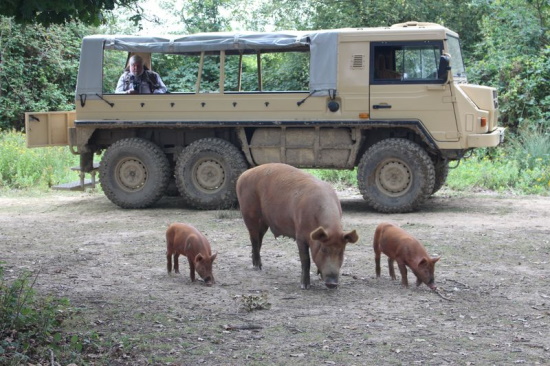
Tamworth pigs
In addition, the increased range of insect species has been accompanied by an increase in the number and density of insectivorous birds such as fieldfares and nightingales, with the latter being a notable success with some 22 territories established in the hedgerows. Ringing of these nightingales has shown that most return to the same area each year with one male having been trapped for ringing on each of six years. In addition, the re-wilding has resulted in the return of a large number of less common species of birds such as turtle doves, grey herons, hobbies and woodlarks and predators such as Red Kite, Goshawks, Long, Tawny and Short Eared owls. There were also three male cuckoos tagged.
The project has therefore shown that, given the right management, wildlife declines can be reversed - an inspiring visit.
David Ware FRSB
Guided tours of the house, estate and gardens at Polesden Lacey
12 June 2019
Of the three guided tours that we enjoyed this day, the first was rather a deviation from our usual visits - a ‘highlights’ tour of the house. There has been a house on the site since the Doomsday book but the current house dates from just 1820 and was bought in 1906 by Margaret and Ronald Greville.
Its interiors were then transformed and were the site of legendary weekend parties with guests including literary figures, politicians and royalty. Upon Margaret’s death the house was passed to the National Trust, however her jewellery was given to the royal family and one can often see reports of royalty wearing pieces from the ‘Greville Collection’.
Area ranger Jamie Parsons, led us around the 1400 acre estate. Most of the estate is managed by tenant farmers who have bought into the estate’s philosophy of limited cattle then sheep grazing, followed by late cutting to enable native species to flower and set seed. Eventually it is hoped that much of the land will be returned to wildflower meadow. Over the last five years, there has been strong evidence of the return of many species of butterfly, including the grizzled skipper, and of many species of orchid.
The woodlands were planted over 40 years ago, mainly with beech for commercial exploitation, however National Trust thoughts have since changed and hazel has been grown, coppiced, and used for charcoal making and for electricity generation via a biomass boiler. The hazel coppicing has shown ecological benefits, supporting many species of moth and butterfly and providing shelter for ground-nesting birds such as the nightingale, nightjar, yellowhammer and willow warbler. Dead and decaying timber is left in the woodland to encourage insects and insectivorous birds.
Heavy rain interrupted our final tour, of the formal gardens, though we did get to see Maggie Greville’s kitchen garden, required to provide for her famous hospitality, and the walled rose gardens from which she had the shallow and nutrient poor chalk soil removed to be replaced by enriched and chalk-free loam. We were also able to appreciate the extensive herbaceous borders resplendent with begonias and alliums and some outstanding views.
David Ware FRSB
Holborough Marshes Nature Reserve
26 May 2019
By controlled irrigation this 34 hectare reserve on the flood plain of the River Medway provides a superb range of wetland habitats including tidal brackish reed beds, freshwater marsh, scrub, woodland, and even some chalk grassland. It therefore supports a wide variety of plant species including many species of orchid.
It is also an important reserve for birds with the reed-beds, scrub and woodland providing over-wintering for waders and wildfowl and suitable nesting sites for reed bunting, reed & sedge warblers and nightingales, one of which was heard but not seen. The site is part of the Holborough to Burham Marshes SSSI.
Led by Stephen Weeks, the estates manager from Kent Wildlife Trust, some 13 members and guests enjoyed a guided walk through the fields and along the Medway.
One interesting finding in the water meadows was hemlock water dropwort (Oenanthe crocata) which is reportedly the most toxic plant growing in Britain with, especially concentrated in the roots, a powerful neurotoxin that can trigger spasmodic convulsions, usually followed by sudden death.
Because of this lethality the Wildlife Trust are undertaking control measures which include cutting the stems before the plants can flower and then a process of drying and burning.
Another plant of interest was the marsh mallow, (Althaea officinalis), common in South and East England but uncommon elsewhere, and of interest for its reported culinary and medicinal properties but also as the main food source for the marsh mallow moth (Hydraecia osseola). For this moth the Medway basin is an important reservoir with the eggs overwintering on the leaves of the plant then, in the spring, hatching with the larvae feeding on the stem before migrating to the root where they pupate underground.
It was a most enjoyable and informative event.
David Ware FRSB
Annual General Meeting and Lecture “From Golden Rice to Scarlet Tomatoes: Where Do We Go From Here?”
Speaker: Professor Paul Fraser - Royal Holloway, University of London.
2 May 2019
There is currently increased pressure to develop economic alternatives to chemical refining using fossil fuels. Professor Fraser explained that this issue can be alleviated using plants and microorganisms instead to produce these valuable compounds. However, despite its drawbacks, chemical refining remains rapid, efficient and relatively cheap, making it harder for “greener” methods to compete.
The carotenoids comprise one such group of compounds, most of which rely extensively on chemical refining. These constitute a large group of brightly-coloured compounds, with a variety of useful characteristics, especially their role as antioxidants and colouring agents. Such compounds as ketocarotenoids and astaxanthin are almost wholly produced from petrochemicals, and the annual market for carotenoids currently rests at $1.5 billion.
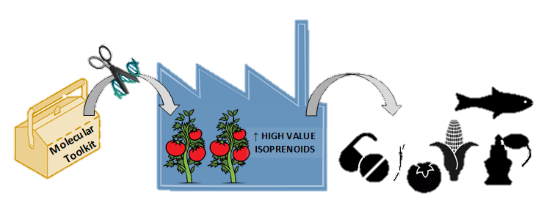
Many plants produce naturally high levels of carotenoids, such as lycopene and ß-carotene in tomatoes. Their output can be enhanced (and changed) by chemical mutagenesis and transformation, and tomato strains have been modified to produce even higher concentrations of ketocarotenoids. Such methods also lay the foundation for future competitive biotechnological production of other compounds.
The growing of GM crops has increased steadily over the years, with an industry now worth over $12 billion spread over 469 million hectares. Newer editing technologies have been developed, such as sequence-specific nucleases (CRISPR/Cas), allowing for seamless and efficient gene-editing. Professor Fraser explained, however, that with such highly specific and selective processes, accountability and detection are an issue, especially with the introduction of short gene sequences, and that this must be resolved if the industry is to be effectively regulated.
Mr Jamie Holland AMRSB
Autumn Colour at Wakehurst
11 November 2018
Autumn in Wakehurst is always a celebration of stunning leaf colour, though sadly this year strong winds had stripped many of these leaves from the trees. However there was more than enough colour and form for a memorable walk led by Paul Reader, a recently retired garden team manager and our very knowledgeable guide. He started the tour by giving us a brief history of the house and the estate. Built in 1590 by Sir Edward Culpeper, the mansion originally included a complete court-yard, though structural problems later led to the mansion being reduced to its current E-shaped plan.
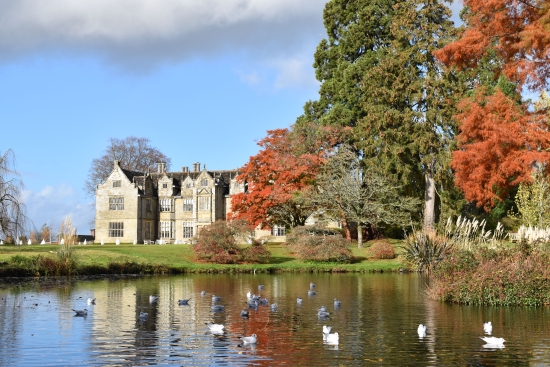
The gardens, we learnt, were largely created by Gerald Loder who purchased the estate in 1903 and spent 33 years bringing back specimens from around the world. Then in 1987 the great storm severely depleted Loder's plantings, toppling 20,000 trees. However since then the area has been re-designed, for example by the inclusion of an Asian heath garden with plants from Japan, Korea, Taiwan, China and the Himalayan chain.
Other areas of interest included the 40 acre Loder Valley Nature Reserve with its woodland, meadowland and thriving population of dormice, the Wetlands, recently improved with new boardwalks, a garden specifically designed to attract pollinating insects and a walled garden with its precision cut Yew hedge.
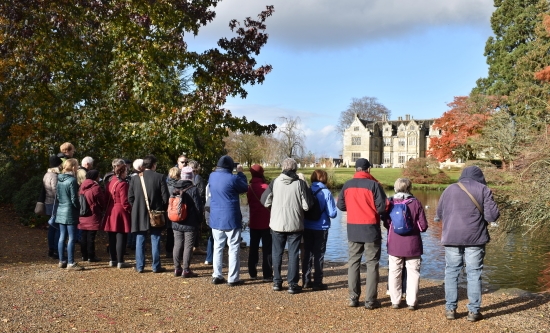
Wakehurst is also home to the largest growing Christmas tree in England, a giant redwood lit by around 1,800 lights which, at night, is said to be visible to planes on a flight path to Gatwick.
David Ware FRSB
Saving the seed corn
11 November 2018
By collecting and preserving as many as possible of the world’s wild-plant seeds, the Millennium Seed Bank provides a most valuable insurance policy against the extinction of plants in the wild.
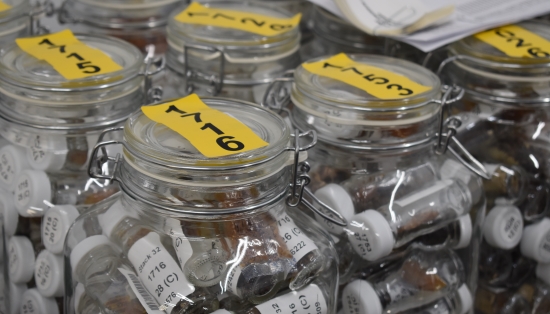
To achieve this the Royal Botanic Gardens at Kew coordinates the Millennium Seed Bank Partnership. The bank vault is part of the Millennium Trust Millennium Building in the grounds of Wakehurst Place, and Professor Hugh Pritchard FRSB (head of comparative seed biology) showed us around the laboratories and the bank.
As we toured the laboratories, dry rooms, cold rooms and other facilities we were talked through the process by which seeds from some 154 countries and over 38,000 different species, including from virtually all the UK’s native plants, have been collected and preserved.
Much of this collecting is by local specialists who know the plants in their area and can collect not only seeds but also make a pressed plant specimen, including the flowers, so that the species’ identity can be confirmed. Generally, seeds collections are kept in the originating country and Kew holds the duplicate.
Not surprisingly the seed accessions arrive at Kew in varying states of humidity and are then immediately moved to a dry room, at around 15% relative humidity. This drying process assists in the preservation of the viability of the seeds until the cleaning can be conducted. However, drying can reduce the viability of some seeds, with some tropical tree seeds being particularly sensitive. In these cases, researchers are exploring how to cryopreserve the material.
After cleaning by hand, seeds are examined and insect infested, immature, diseased or malformed seeds are removed.
The seeds are then banked at -20°C in hermetically sealed glass containers or tri-laminated foil bags, along with silica gel packets impregnated with indicator compounds that change colour if moisture seeps into the container. Seeds are tested for viability with a germination test shortly after banking and then at around 10 year intervals.
Once prepared and stored these seeds are also available for research by Kew’s scientists, confronting vital problems such as the biochemistry of drying tolerance and the biophysics of glass formation in seeds, the breaking of seed dormancy and the storage of the most delicate and recalcitrant seeds. Preserved seeds may also be made available to other bona fide, non-commercial organisations and research workers.
David Ware FRSB
Fungal Foray in The Chantries
7 October 2018
This annual event was led as usual by Professor Maurice Moss. Although there had been a downpour the previous day, the long dry spell had taken its toll, but there were enough interesting finds. It suffices to highlight those of note with full list available to download.
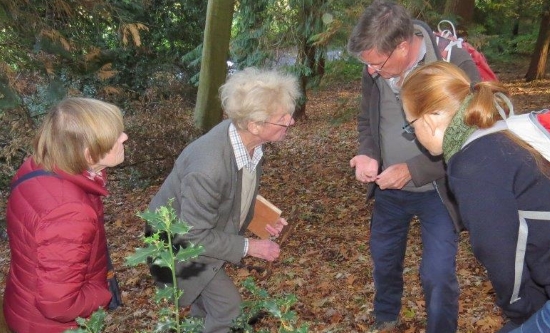
The velvet shank, Flammulina velutipes, found on decaying deciduous trees, is one of several British species, highly prized in Japan, where it is known as enokitake. The familiar artist’s bracket, Ganoderma applanatum, was evident, also. Although indigestible raw, the species is used in Asian cuisine owing to its rich mushroom flavour.
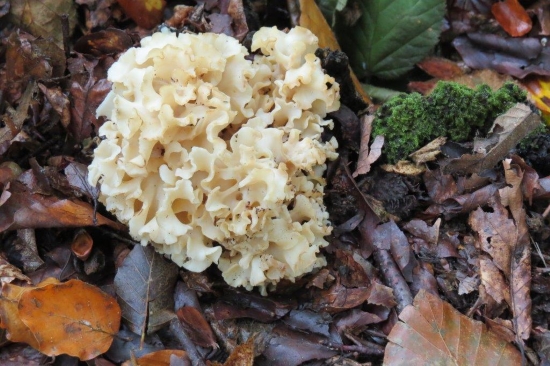
Another find, the milkfoot (Mycena galopus) is a saprophytic species, attacking both cellulose and lignin, and its latex produces benzoxepines which are thought to be produced against wound-activated yeasts and parasitic fungi. There were several specimens of cramp balls, Daldinia concentrica, named after the tradition that they ward off muscular cramp; these can be ignited (hence an alternative name of King Alfred’s cakes), burning slowly, much like charcoal.
The birch bracket, Piptopterus betulinus, was once used as a razor strop and for mounting insects, although recent updates on its use by Otzi the Iceman suggest that ground up, it may have served him as a laxative to expel eelworms! Another interesting find was the cauliflower fungus, Sparassis crispa, which is good to eat, but needs careful cleaning to wash out insects and general debris which it encloses as it grows.
Finally, we discovered the candlesnuff fungus, Xylaria hypoxylon, which is said to luminesce mildly in the dark, perhaps more so before being ‘snuffed’!
Dr G Godfrey CBiol FRSB
Bats at Knepp Estate
14 September 2018
Bats are so delicate that even the difference in air pressure on either side of the blade of a wind turbine may be enough to damage their lungs and eardrums, especially if these turbines are placed on hill tops used by the bats as flight paths.
This and many other fascinating bat insights, were presented by Amanda Millar, chair of the Sussex Bat Group and administrator of the Hurstpierpoint Bat Hospital, from which she brought some injured bats for us to view. We then, carrying bat detectors, walked around some regular feeding runs for the 13 species of bat present on the Knepp estate.
From Amanda’s talk we learnt that in the autumn, prior to hibernation, British bats normally mate, with the females storing the sperm until the next spring when fertilization occurs. Then, some six to nine weeks after fertilization, the baby bats are born, naked. However, fed solely on milk, their growth is so fast that, after just a few days, the young may weigh up to one third of the weight of an adult and may become too heavy for the adult to carry. Then, after just three to five weeks, they normally fly. Sadly, many die in first year if they fail to catch sufficient food, or if they fail to avoid predators such as owls and sparrow hawks or navigate around glass and other hazards. If they survive a year then many live some 10-20 years.
For hibernation most bats seek cool, quiet roosts within which their temperatures can fall to 6°C, their heart rate can decline from 900 beats per minute to as few as 20, while their respiration can drop to an almost imperceptible rate.
David Ware FRSB
Introduction to Sussex IFCA
15 August 2018
The fishing industry off the South coast includes trawlers mainly pursuing sole, bass and cod, an oyster fishery in Chichester harbour, vessels with pots, nets and traps catching whelk, lobster, crab and cuttlefish, and individual recreational fishermen fishing off piers and harbour walls or from a flotilla of small privately owned craft.

Yet, despite all this activity the major harvest from these seas is whelks, for which there is only a small market in the UK. Most are therefore exported to the Far East.
This and much more was learnt by our members when we visited the Inshore Fisheries and Conservation Authorities (IFCA) headquarters in Shoreham. We were addressed by Tim Dapling, the chief officer, Professor Paul Leonard, a Marine Management Organisation appointee of the IFCA Board, and Kathryn Nelson, who informed us about her research, especially with regard to the monitoring of sea bream in the Kingmere Marine Conservation zone, offshore from Littlehampton.
This Kingmere area, despite being a conservation zone, is also an important spot for angling, especially from April to June when the black bream have returned from deep water off France to the Sussex coast for females to lay their eggs in small nests dug by the male fish. To protect the stocks anglers are limited to four bream per angler per day, normally retaining just the males. However bream are protogynous – that is, females can change sex to males if there is a shortage of spawning partners.
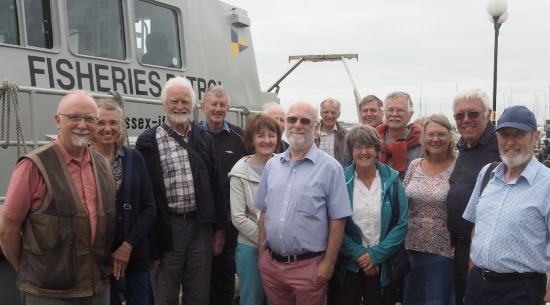
To further understand this population, the Sussex IFCA has undertaken a range of research projects, for example working with local charter angling skippers to attach external identification tags to sea bream. The positions and details of these fish are recorded then, when recaptured, position and condition information is gathered and used to further inform our understanding of the migration patterns and site fidelity of these fish.
David Ware FRSB
Private Guided Tour of Whitmoor Common
24 July 2018
Sixteen members of the Branch set out on what turned out to be the second highest temperature of the summer to visit Whitmoor Common, a lowland heathland SSSI near Guildford, which also forms part of the Thames Basin Heaths SPA.
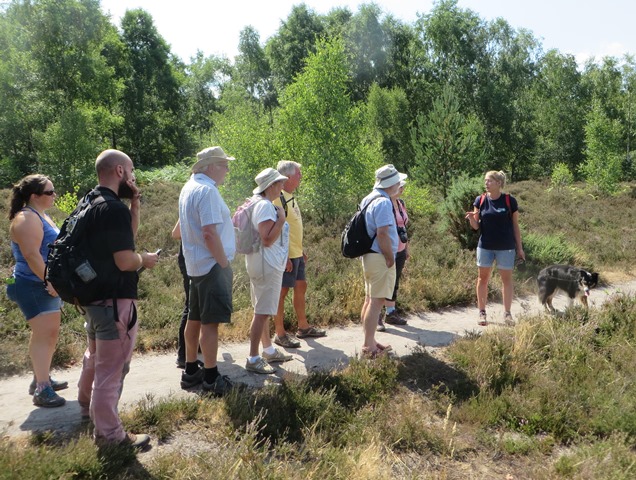
Paradoxically, whilst an internationally important habitat, lowland heathland is comparatively poor floristically, though the group managed to see all three Surrey species of heather in flower: mainly ling Calluna vulgaris and bell heather Erica cinerea, with cross-leaved heath Erica tetralix found on the normally wetter areas.
Katy demonstrated that the site was managed to provide a mosaic of heather of different ages, along with bare ground, to provide suitable habitat for invertebrates and reptiles, though some trees were retained to act as song perches for birds and as food sources for shield bugs, etc, the latter being important for some aculeate Hymenoptera. The site also has a good population of silver studded blue butterflies Plebejus argus, which require short turf to ensure optimum ground temperatures for the ant species it relies upon.
Although the site was extraordinarily dry when visited, it is only one of 7 known locations in England for the window winged caddis fly Haganella clathrata, which lives in small pools under purple moor grass, and the hydrology of the site is now under close observation to ensure that this species is not lost.
Nick Baxter CBiol MRSB
The ancient wildflower meadows of the Beech Estate
24 June 2018
Removing a fallen tree from the lane, rescuing a fawn from a barbed wire fence, the hospitality of the farmer and his family and enjoying the rich flora of these meadows all helped to make this trip a very memorable experience.
The Beech estate is a 2000 acre working organic farm in the High Weald of Sussex; an area of outstanding natural beauty. The land on which the estate sits is typically Wealden clay and sandy loams and not really suitable for arable farming, in fact the meadows of this estate have not, in living memory, ever been ploughed but have for generations been farmed by low intensity grazing by sheep and cattle and by late mowing, a regime that has ensured their continuation as nutrient-impoverished but species rich meadows which have been reported as supporting some 50 species of plant per square metre and up to 34 different species of butterfly. There are also such large numbers of deer on the estate that they have to be regularly culled.
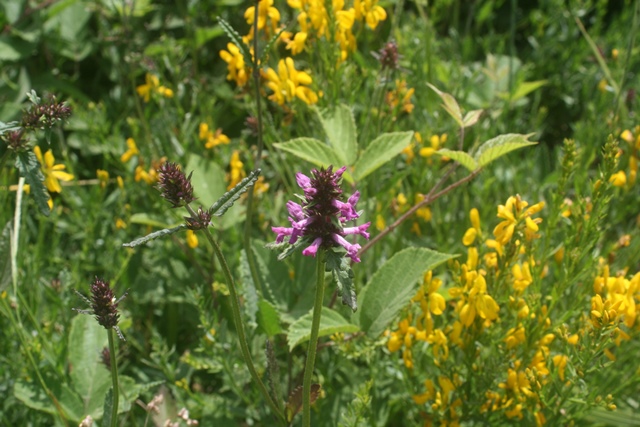 All of the land is included in either Entry Level or Higher Level Stewardship Agreements, the grants from which have enabled the owners to manage the estate for this biodiversity. There has also been some financial gain from late summer mowing for herbage which is rich in wild flower seeds and so can be sold or scattered onto adjacent meadows to enrich their flora. However any process of naturalisation takes many years fully to mature.
All of the land is included in either Entry Level or Higher Level Stewardship Agreements, the grants from which have enabled the owners to manage the estate for this biodiversity. There has also been some financial gain from late summer mowing for herbage which is rich in wild flower seeds and so can be sold or scattered onto adjacent meadows to enrich their flora. However any process of naturalisation takes many years fully to mature.
In addition to the meadows, this High Weald area had, since pre-roman times, seen the mining and smelting of iron, the impacts of which on the landscape have further contributed to the diversity of habitats in the reserve.
This was a most interesting and rewarding event.
David Ware FRSB
Glimpsing the less common species of British Wildlife
9 May 2018
It has been reported that eagle owls, the largest of the owls, with a wingspan of over 1.5 metres, normally found in the mountain valleys and coniferous forests of northern and Eastern Europe, may be becoming established in Britain; a possible threat to indigenous species and even to young lambs.
This formidable predator is still however a rare sight – though we were introduced to a mature specimen during our guided tour of the British Wildlife Centre in Lingfield, Surrey.
The centre, formed in 1994 primarily as an educational resource, now contains some 40 species of British wildlife including all six of our native mustelids plus an American mink, now an established species. There are also four of the six species of deer found in the country and four of our native owls, plus the eagle owl and a snowy owl, though not, at present, a short eared owl.
It is also of significance that most of the animals in the centre were either born there or in other wildlife parks, or were orphans who could not be released back into the wild.
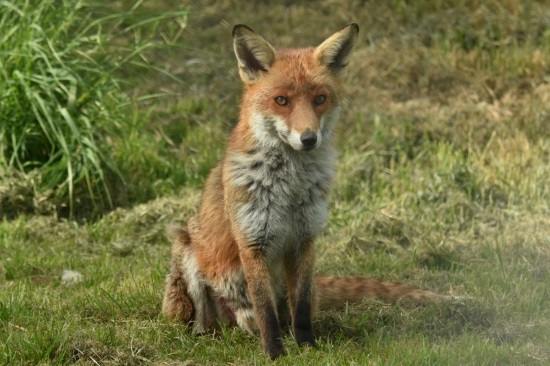
Photograph courtesy of Graham Westake
For this private visit our guide not only told us about the animals, and lured them from their hideouts with tit-bits of food, but also told us about the breeding programs that the centre runs, for example producing two wildcat kittens that can be exchanged with other centres to form a breeding stock uncontaminated by feral cats, which have insinuated their DNA into the native Scottish population.
The centre is also the biggest breeder of red squirrels in the country, rearing 50 or 60 kits per year then passing them on to join new colonies, for example on Tresco Island in the Scillies and Caldey Island off the Pembrokeshire coast. An excellent opportunity for us to brush up our identification skills.
David Ware FRSB
God Save the Queens
24 April 2018
Bumble bees are in decline, with many having undergone dramatic declines in range in the UK. Without the whole range of pollinating insects we could lose many of our food products as well as many flowering plants.
As Professor Brown explained during a lecture to the branch and guests, this loss of bumble bee numbers and species appears to be multifactorial, being a consequence of the decline in the number and range of wild flower species, the prevalence of emerging parasites and the widespread use of pesticides.
A major factor in the decline of pollinating insects is thought to be the increased use of the neonicotinoids for, when applied as seed dressings or as sprays, these insecticides have been shown to appear in pollen and in nectar, and to leach into wild flowers and thus adversely affect pollinating insects. For example they have been reported to reduce foraging behaviour, increase worker mortality, affect egg laying by the queens, alter hibernation duration and impair brood development.
In addition to these anthropogenically driven stressors, bumble bees also face natural stress, including endemic parasites. Of these perhaps the common and abundant trypanosome Cnithidia bombi is the most significant, infecting several common bumble bee species, affecting ovarian development in the queens and thus negatively impacting on their reproductive fitness. These parasites also affect early colony establishment after the queens have emerged from hibernation.
Using laboratory experiments to simulate the anthropogenic stressor of the neonicotinoid, thiamethoxam, and the natural stressors of hibernation and parasitism, it was possible to determine the impacts on queens and populations. While the parasites alone had little or no effect, the addition of low doses of thiamethoxam to queens reduced egg laying. Mathematical modelling showed that these impacts could seriously reduce population persistence.
David Ware FRSB
Guided tour of the Houses of Parliament
12 February 2018
At a time when our environment is changing through advances in technology, methods in farming and food science, and medical research, the RSB has become increasingly involved in major issues of national and international importance. A group of KSS members were fortunate to visit Westminster Hall and many parts of the Houses of Parliament with a view to learning how the complex interests of our Society pass through Committee stages through to the Houses of Commons and Lords.

We appreciated the expert guidance of Dr Stephen Benn, director of parliamentary affairs for RSB. His principle role is to represent scientific societies, to raise the profile of science and to strengthen links between the science community and government.
After a detailed history of the House from early times, and reminders of how notable politicians and royalty have influenced its development over the past millennium, we were treated to a guided tour of the extensive galleries adorned with politicians and dignitaries of earlier times, robing rooms and lobbies. Each has a fascinating story.
Dr Benn explained the importance of the Committee stage as an initial step in creating legislation in a true setting. The secretary of the KSS branch presided over a mock session with questions relating to the increasing importance of input from RSB in discussions on contentious subjects like GM crops, the use of laboratory animals and genetics.
With a second guide, we visited the chambers of the Houses of Lords and Commons resplendent with their red and green leather seating (for use by sitting members only). From the Government benches we gazed on the opposition, speaker's chair and positions of House officials. It was a great experience and an opportunity to understand the procedures in the House.
For us, this well organised event provided an insight into how our various studies in biological sciences progress through to national affairs.
Alan Lansdown FRSB
Annual Fungal Foray at The Chantries
8 October 2017
The guide for this annual event at the Chantries was our intrepid guru, Professor Maurice Moss. We discovered a potpourri of fungi, and one can see from the accompanying photograph the enjoyment and enthusiasm that our tour generated, disclosing as it did such strange phenomena as stinkhorn “eggs” and snapping bonnets!
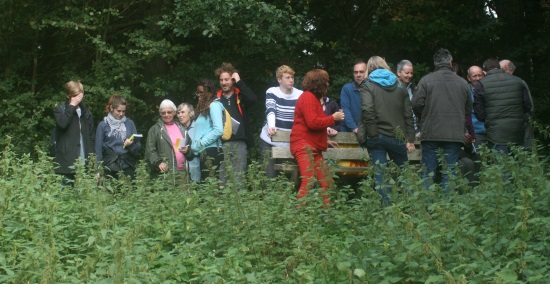
During the tour we found many species and learnt about their importance in the applied sciences. The common and often highly coloured turkey tail, Trametes versicolor, for example, yields the glycoprotein krestin, or PSK, which has been used with success as a post-operative adjunct to chemotherapy in the treatment of certain kinds of cancers.
The clouded agaric, Clitocybe nebularis, is a source of the purine nucleoside nebularine, which has interesting antibiotic, antiviral, antamoebal, antiparasite and cytotoxic properties. Nebularine has been used recently for the synthesis of more powerful antitumour drugs.
Another of our finds, the false deathcap, Amanita citrina, is a source of the psychoactive tryptamine alkaloid bufotenin, which is found also in the skin and parotid gland venom of certain species of Bufo, hence its name.
It is axiomatic that the bracket bolete Ganoderma aplanatum is called the artist’s fungus owing to its being marked on the under surface as a visible line when scratched. Less well known is that it possesses powerful antibacterial properties, and in her book Gorillas in the Mist (1983) Dian Fossey described how these primates ate G. aplanatum as a delicacy, even squabbling amongst themselves to obtain a morsel, but should the silverback come along he takes the lot! Do our simian cousins know something about self therapy that we don’t?
Download full list of identified species.
Dr Graham Godfrey CBiol FRSB
Brogdale Collections
17 September 2017
It was 'Pear Day' at Brogdale Collections when our branch visited in mid-September. Brogdale farm, near Faversham in Kent, has been home to the National Fruit Collection since 1952.
It now holds more than 2,000 varieties of apples and 500 varieties of pears, with two trees of each variety, as well as trees bearing cherries, plums, quince, cobnuts and medlars.
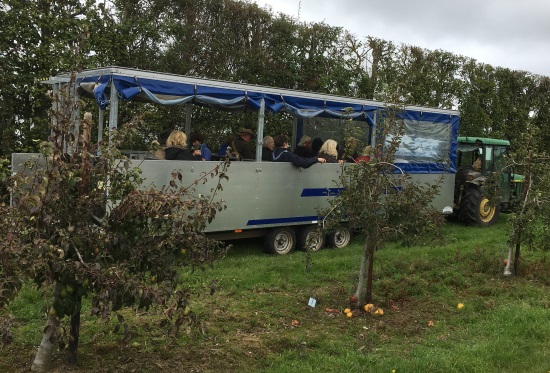
On arrival we were taken on a guided tractor and trailer tour, passing through some of the collections with information on the history and uses of many of the varieties.
Currently the trees are owned by DEFRA but responsibility for the curation and maintenance of the collection has been taken over by the University of Reading in collaboration with the Farm Advisory Services Team (FAST), who are based at the farm. Public access is organised by Brogdale Collections, who are developing the site as a visitor attraction.
The work now done at Brogdale is more correctly termed 'trialling' rather than 'developing' pear varieties. A current 'trial' at Brogdale is examining the effects of global warming, with trees being grown at temperatures raised by 1, 2 & 3°C.
On the tour we were offered a tasting of a few of the less well known varieties of pears and were pleasantly surprised by some of the flavours; quite different to the traditional supermarket offerings. Brogdale has other special event days throughout the fruit season, including a strawberry fair, cherry fair and apple and cider festivals. It is a good place to visit if you are planning to plant fruit trees and wish to consider the less common varieties.
Conrad Chapman FRSB
The science of lavenders
18 June 2017
On a warm Sunday in June nearly 30 members, their families and friends enjoyed a guided walk around the lavender beds of the Downderry Nursery, led by Dr Simon Charlesworth. Simon has, since 1991, been building up an extensive lavender collection. In 1996 the collection was granted National Plant Collection status and now it is the country's premier lavender nursery with some 400 varieties. It is also the world's only Scientific National Plant Collection of lavenders.
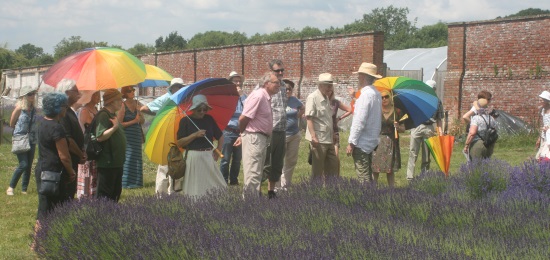
The lavenders (Lavandula sp.) comprise a genus of at least 39 species native to the Mediterranean region, also found in the Middle East and in North and West Africa but not to the UK – though one of the most common species, Lavandula angustifolia, is known as English lavender.
As is well known, most lavenders have a characteristic scent and produce valuable oils contained in fine hairs on leaves and in glands at the base of the calyx. Each oil has its own fingerprint of terpenes, esters and alcohols and each has its own spectrum of uses including perfumes and cosmetics, antiseptics and insect repellents. Some have even been recommended for treatment of a range of maladies, while others are recommended for culinary use.
Besides L. angustifolia, another species commonly grown in the UK is Lavandula latifolia, known as spike lavender, grown for its a stronger scent and pale flowers produced at the top of slender, leafless stems. This L. latifolia has been hybridised with English lavender to produce lavandin, (lavandula x intermedia), a variety which has been shown by professor Ratnieks' group at Sussex University to be almost four times more attractive to bees than the most attractive L. angustifolia cultivar.
Dr David Ware FRSB
A guided stroll through ancient woodland
7 May 2017
On a perfect day for walking, some 20 members, friends and their families were guided around the ever interesting woodland of Ebernoe in West Sussex by Mark Monk Terry from Sussex Wildlife Trust.
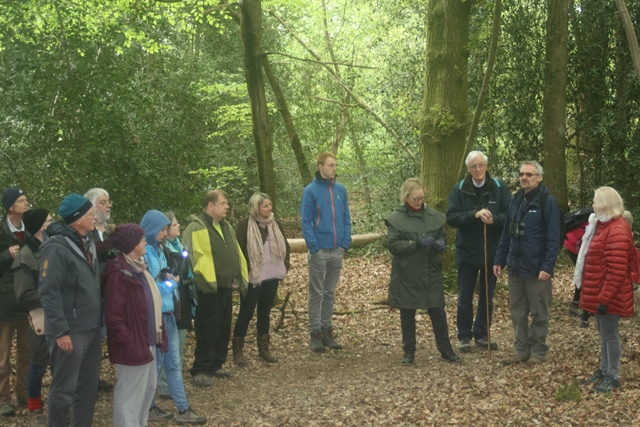
This nature reserve is mainly Low Weald woodland with a history of traditional use. For centuries commoners would turn out their cattle or pigs to graze and browse, while the Wealden clay was used for brick making and the timber for smelting iron ore. The remains of all these industries are still written in the landscape, with hollows where clay was excavated and streams dammed into ponds to feed water wheels.
In addition to its industrial heritage the wood is also an SSI, in which a total of 3,720 species have been recorded – including 961 species of fungi and 481 Coleoptera, including some rare saproxylic species.
The site is mainly broadleaved deciduous woodland, with glades and pools maintained by repeated mowing and raking by volunteers and, mainly in the late summer and autumn, by the introduction of British white cattle. This attention has enabled the return of a rich and varied flora including many orchid species.
A major feature of this reserve is the 15 species of bat that have been identified here, including a colony of barbastelle bats, which need old dying trees with loose bark for their roosts. There is also a colony of Bechstein’s bats, mainly roosting in old woodpecker holes in the stems of mature sessile oak trees. Radio-tracking devices affixed to trapped individuals have indicated that the barbastelles can move over a 25 mile radius, whereas Bechstein’s bats tend to stay within the woodland, taking insects from trees. Our enjoyable and informative walk was capped off by the song of a nightingale.
Dr David Ware FRSB
Guided tour of Pierrepont Farm
19 March 2017
It is possible to run a modern farm and to care for its wildlife? That was the question addressed on our recent visit to Pierrepont Farm, run by the Countryside Restoration Trust (CRT).
Launched in 1993 in response to growing fears about intensive and industrialised farming, the CRT aims to purchase farmland and woodland where the wildlife habitat and biodiversity are under threat and, using mainly traditional farming methods, to restore it to a living countryside.
We were introduced to the project by the education officer, Annika Rice, who explained that this farm, given by Jo Baker in 2006, is one of 12 properties owned and run by the trust. It covers some 500 acres and includes a dairy herd of 130 milking cows, mostly Jerseys, the milk of which contains around 5.4% butterfat, which significantly increases its value.
One major point of interest was the automated milking parlour which cows visit at their leisure up to five times night or day, a process that reduces labour costs and increases the milk yield by up to 10%.
The farm also includes a water meadow, a biodiverse pond, an area of woodland and some generous field margins.
The wildlife over the farm is monitored by Bill Young and Brian Lavers and a team of volunteers who also carry out work to improve biodiversity. For example, they have been clearing from the woodland Rhododendron ponticum, which tends to smother other plants and deter some wildlife.
Presumably as a result of the farming methods employed, the meadows have been reported to contain some 128 different species of plants as well as 82 species of birds and 52 species of macro-fungi. There is also a range of invertebrates including the European wasp spider (Argiope bruennichi), a large and colourful introduced species which builds webs in grassland. There is also a badger set but no hedgehogs; two possibly related findings. A most interesting and instructive day.
Dr David Ware FRSB
Fungal Foray at the Chantries
23 October 2016
A goodly crowd attended our annual foray at the Chantries under the indomitable guidance of Professor Maurice Moss. As expected, a multitude of diverse fungi cropped up, ranging from the very large polypore bracket Rigidoporus ulmarius (a specimen found at Kew in 2003 measured 425cm in circumference) to tiny species of Mycena. Other large brackets discovered were the southern bracket, Ganoderma australe, the giant polypore, Meripilus giganteus (a massive cause of white rot in beech), the resinous polypore, Ischinoderma resinosum, and the birch or razor strop fungus Piptopterus betulinus. Download a full species list.
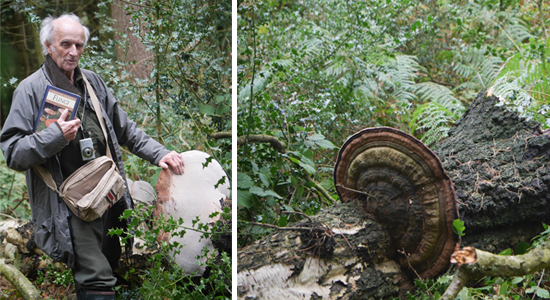
An abundance of other species came to light of course, and a list will appear on our website. It suffices here to highlight some finds whose properties warrant further comment. For example, the panther cap, Amanita pantherina, an ectomycorrhizal symbiont of beech contains the psychoactive compound muscimol, a GABA agonist used often as an enthogen. Regarding the lilac bonnet, Mycena pura, as well as containing the antifungal agent strobilurin, belonging to a group of fungicides used in agriculture and horticulture, it also yields puroquinoic acid, a sesquiterpene, which induces mammalian line HL60 cells to differentiate into macrophage-like or granulocyte-like cells.
Now a salutary word of caution: the common roll rim, Paxillus involutus, has often been judged by some as edible and eaten without apparent ill effects. However, in 1944, the respected mycologist Julius Schaffer died of renal failure several days after consuming some, and further cases have since been recorded. It has been shown that the condition is caused by an autoimmune response involving IgG antibodies and erythrocytes, resulting in immunohaemolysis, and after repeated consumption such fatalities can commonly occur. So, be warned: the effects of eating the wrong mushrooms can creep up on you!
Dr Graham Godfrey CBiol FRSB
HPV: breaking the taboo
17 October 2016
In 2014, the last date for which data are readily available, some 890 women in the UK died of cervical cancer, with 99.7% of these cancers being associated with an infection involving high risk human papillomavirus.
Infections with HPV are extremely common, with most not resulting in cancer. For example of the 100 or so types of HPV identified only 13 strains have been defined as oncogenic and just two types, 16 and 18, have been associated with 70% of cervical cancers.
These and many other important pieces of information were passed to the girls of Sutton High School by Kirsty Brown, information officer at Jo’s Cervical Cancer Trust. This charity is devoted to providing information and support on all aspects of cervical abnormalities and cervical cancer, including HPV vaccination, which currently affords the best protection against cervical cancer, especially if given before contact with high risk HPV types.
Kirsty went on to explain that infection is primarily by genital-to-genital skin contact, and during vaginal, anal or oral sex. However the virus can remain dormant for long periods of time so often it is not possible to determine exactly when or from whom the infection originated.
Kirsty then discussed the major risk factors associated with cervical cancer and how this risk may be reduced, for example by practicing safe sex, by quitting smoking, by leading a healthy life style, by having the HPV vaccination and by attending cervical screening (smear tests).
However, if a woman does become infected with high risk HPV and her immune system is unable to clear it, then the virus can cause abnormalities of the cells of the cervix. It is these abnormalities that are detected during a smear test. These cells may then be treated before cervical cancer can become established.
Dr David Ware FRSB
Darwin and his beetles
11 September 2016
JBS Haldane, when asked if the study of natural history offered any conclusions as to the nature of God, replied that “the Creator, if He exists, has an inordinate fondness for beetles”.
So had Charles Darwin, and on a warm and sunny September afternoon in Darwin’s house in Downe, Kent, we were treated to a talk on Darwin’s fondness for beetles by Max Barclay, Coleoptera and Hemiptera collections manager at the Natural History Museum.
There are at least 400,000 beetle species worldwide, more than any other insect group. These comprise some 25% of all known animal species. Darwin, although a poor student, was an avid beetle collector, and this played a part in his development of the theory of evolution by natural selection. On one of the Canary Islands he found many beetles that could not fly, while similar beetles on the mainland could. He reasoned that both could have come from the same stock but that on the island there was a selective advantage in being flightless; for example, the beetles would have been less prone to being blown out to sea.
New species of beetle are being discovered daily, not only in wild habitats but in old museum collections. Darwin contributed to the 200,000 species currently preserved in the Natural History Museum, and one rove beetle he collected during his 1832 expedition to Bahia Blanca, Argentina, was only recently recognised as a new species. In 2008, Dr Stylianos Chatzimanolis, an entomologist at the University of Tennessee at Chattanooga, named the genus and species Darwinilus sedarisi.
As Chatzimanolis said to National Geographic magazine: "There is a famous Darwin quote about beetles:…'Whenever I hear of the capture of rare beetles, I feel like an old war-horse at the sound of a trumpet.' Darwinilus sedarisi certainly qualifies as such a discovery.”
Dr David Ware FRSB
Kipling’s Haven
14 August 2016
Beautiful weather, a captivating garden, a knowledgeable and interesting guide and a cream tea. What better way could there be to spend a Sunday morning?
Some 20 members enjoyed this tour of Bateman’s, Rudyard Kipling’s house and garden, maintained to reflect Kipling’s design. The result is an early 20th century house, enclosed by a 12 acre garden set in a 300 acre landscape of farmland and ancient woodlands, with some of the latter enclosing small pits and ponds; remnants of a once prosperous iron industry in the locality.
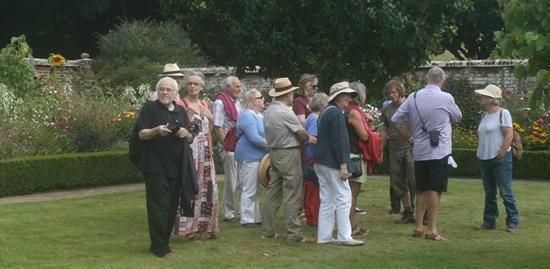
The garden is, in fact, a series of gardens; some enclosed or divided by brick walls. First we were introduced to the orchard which, along with more common fruit, contained medlars, quince and a black mulberry. There was also a salad, vegetable and herb garden which provided produce for the house, while facing the front of the house was an alley of pear trees on wire frames, so arranged that the owner, sitting at the far end, could look through it to the house in the near distance.
Through a gate we were in the front garden, with its lawns enclosed on three sides by flower borders. Then past the lily pond with its river-fed fountain, over which some 19 species of dragon and damsel fly and four species of bat have been identified. Then through the rose garden to the water garden which forms a natural flood plain to protect the house from the excesses of the river. Then, further on, past some bee hives, to a water mill which, in Kipling’s time, served to generate electricity for the house.
A very enjoyable day in peaceful surroundings.
Dr David Ware FRSB
Foray through Thursley Common
3 July
Two species of insectivorous plants (the round-leaved sundew and the lesser bladderwor), a wild cranberry and a large female raft spider – complete with egg sack – were amongst the many interesting species found during our walk around Thursley Common, led by the reserve manager, James Giles.
Thursley Common is an SSSI and a National Nature Reserve comprising some 400 hectares of heath-land and mire with small areas of woodland, situated between the villages of Thursley and Elstead in the north west of Surrey.
Luckily, over the mire and wet heath-land a raised wooden boardwalk enabled us to keep our feet relatively dry whilst examining the bog pools and sphagnum lawns for both calcifugal plants such as bog asphodel (allegedly the cause of brittle bone disease in sheep), heath spotted orchid and the less common early marsh orchid.
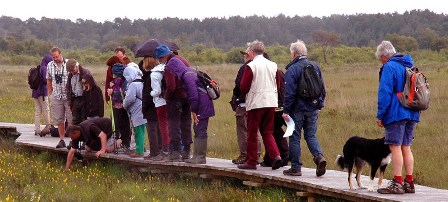
There were also dragonfly species such as the four-spotted chaser, the emperor, common darter, downy emerald and keeled skimmer; just some of the 26 species of dragon-fly reported to have been found on the reserve.
We then moved from the marshland onto the heath where the sandy soil with its outcrops of ironstone was populated by cross-leaved heather, bell heather, heath star moss, ling and dwarf gorse, while over the heather we could see silver studded blue butterflies, the caterpillars of which are often found in the presence of ants, especially the black ant Lasius niger, which are believed to offer the caterpillars some form of protection against parasites and other predators.
As far as animals are concerned we saw quite a few common lizards, but sadly no sign of the much rarer sand lizard, while in the skies woodlarks, stonechats, a meadow pipit, skylarks and a goldfinch flew above us.
Dr David Ware CBiol FRSB
Exploring The Mens
4 June 2016
With its steep slopes, narrow paths and rickety bridges, this walk through the Mens was challenging, but led by the reserves manager, Mark Monk-Terry, yielded some excellent vistas of ancient woodland and interesting flora and fauna.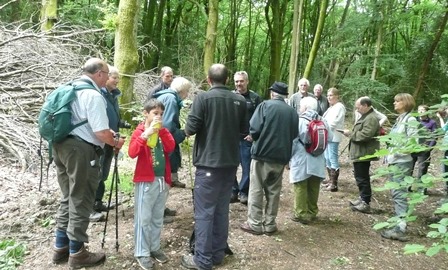
The unusual name of this area comes from the Anglo-Saxon word ‘ge-mænnes’, meaning common land, as it was once used for pannage by farmers with adjoining land and as a source of timber.
However, for the last century or so these woodlands have been left largely unattended, with fallen trees and branches left for saproxylic invertebrates, lichens and wood-rotting fungi. The result is an SSSI of atmospheric beech and oak beneath which were many interesting species including holly, yew, ash, birch and wild service trees with yellow archangel (Lamiastrum galeobdolon), enchanter’s nightshade (Circaea lutetiana), some fine grass (possibly Melva uniflora) and with bryophytes including the star moss (Polytrichum commune).
Following a figure of eight walk through the woods we entered the adjacent meadows, termed the Badlands, which are reported to have never been ploughed or fertilized, or at least not in living memory. They therefore are filled with a range of wild flowers including stands of early purple (Orchis mascula) and common spotted (Dactylorhiza fuchsii) orchids, yellow rattle (Rhinanthus minor), Agrimony (Agrimonia eupatoria), yellow pimpernel (Lysimachia nemorum) and many more – a memorable morning’s walking.
Dr David Ware CBiol FRSB
Great Crested newts and their conservation
8 May 2016
On a hot day in May we visited the Durrell Institute of Conservation and Ecology (DICE) at the University of Kent to hear from Professor Richard Griffiths about their studies of the great crested newt.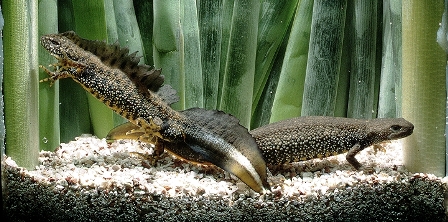
DICE combines a natural and social sciences approach to conservation, focusing on research that can inform practical measures worldwide. In Britain the great crested newt is fully protected by law and, if it is discovered on a construction site, a mitigation licence is required for development to proceed.
However, the factors affecting its successful conservation are incompletely understood, with mitigation requiring not just the preservation of breeding ponds but also the availability of suitable rough grassland and scrub around the ponds to accommodate non-breeding and hibernating adults and juveniles.
This brings ecologists into direct conflict with developers, and there is a mutual desire for speedy resolution of such conflicts.
Following DICE’s work from 1995 until 2014 on this species in ponds at the nearby Well Court Farm, a series of replicated ponds was set up within the Kent University campus. This initially involved newt traps placed at two metre intervals around pond edges, with individual newts identified and tracked using images of the patterns on their underbellies. More recently, the development of DNA techniques promises to become a useful tool for demonstrating their presence and a non-invasive way of identifying individual great crested newts.
From DICE’s long term studies it is clear that the newts do not breed successfully every year, with their breeding success being dependent on a number of factors including the presence of predators such as fish and insect larvae and the weather, with mild winters affecting hibernation and hot summers drying out the ponds. A most interesting and rewarding event.
Dr David Ware CBiol FRSB
AGM and Royal Title Celebration Lecture: Water Fluoridation: Is It Time To Turn the Tap Off?
13 April 2016
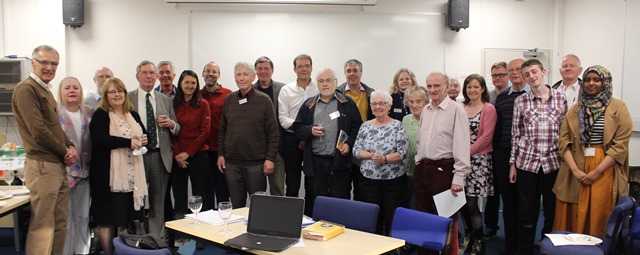
The catalyst for this lecture was my letter, published in The Biologist Vol 62 No 2 p45, in response to an earlier article which included reference to the cariostatic effects of water fluoridation. Professor Peckham's AGM presentation included a review of current practice and the polarised opinions which it generates. The dental profession and government agencies continue to support and recommend water fluoridation in the face of new evidence as to fluoride's side-effects in addition to dental fluorosis (a subclinical symptom of its toxicity), such as skeletal fluorosis, hypothyroidism, nervous system and other soft tissue abnormalities.
Proponents depend heavily upon epidemiological studies made before 1975, and Professor Peckham highlighted the unreliability of much of this data, especially as sampling has been shown in many instances to be slanted (the so- called Gold effect), and its significance therefore suspect. The supporters of public water fluoridation are therefore relying largely upon outdated and unreliable information, and have been reluctant to accept new evidence as to its safety and efficacy.
Our speaker's own recent study of the incidence of hypothyroidism in Birmingham, whose population drinks fluoridated water, has upset several establishment scientists, who accuse him of the same suspect methods and conclusions which they themselves support in maintaining the status quo! The Cochrane Review has concluded recently that the evidence for the benefits of water fluoridation is insecure, so in view of the toxicity of ingested fluoride at relatively low concentrations, and its dubious role in controlling dental decay, a reassessment of the practice is long overdue.
Finally, I refer the interested reader to a review of the molecular mechanisms of fluoride toxicity by Oliver Barbier et al in Chemico-Biological Interactions 188, 319-333 (2010). Also, "Something in the Water" Guardian online,13th April 2016 the very date of our AGM!
Dr Graham Godfrey CBiol FRSB
Monitoring Biological Diversity from Space
15 October 2015
Human activities, through climate change, changes in land use, the release of nitrogen and phosphorus into the environment are all changing our biosphere with one in every 10,000 species reportedly lost per year. While in the sea the number of dead zones, that is where the dissolved oxygen levels have dropped too low to support most marine life, has roughly doubled each decade since the 1960s.
Dr Pettorelli, a research fellow from the Institute of Zoology, explained how data from satellites may be used to monitor these changes to a packed audience of students, staff and RSB members at Sutton High School.
Initially Dr Pettorelli discussed the meaning of the term biodiversity and the impact of human-induced change on the number and ratios of species, with amphibians most at risk. She also covered the quality of human lives, particularly the lives of the poorest segment of a population, for example as a consequence of declining yields from global fisheries. Much therefore needs to be done to mitigate these effects and this will require more finance and more collaborative endeavour.
She then went on to discuss how biodiversity may be monitored, and the value of satellite-based observations in this process. Landsat satellites operating in the visible, infra-red and microwave regions of the spectrum offer a reproducible and sustainable means of deriving environmental information on large or remote areas of the world at a price significantly less that that of field monitoring.
Satellite imagery has been used to detect and map anthropogenic disturbances in desert environments including oil exploration in the Sahara. It has also been used for monitoring penguins on Antarctica via the discoloration of the snow by their excrement, and for predicting the timing of red deer seasonal migration and their reproductive success; a very enjoyable and informative talk.
Dr David Ware CBiol FRSB
Annual Fungal Foray at The Chantries
11 October 2015
Twenty members and friends attended this annual event under the capable stewardship of Professor Maurice Moss (below left). Owing to the quite recent rain, we found an abundance of fungi with which to test our powers of observation and identification.
Naturally, we recorded many species of interest, (a list will be available here shortly), but it is useful to remind ourselves of the important roles that fungi have played over the decades, and still are playing, in drug discovery. On every foray we see, in addition to their intrinsic fascination to the forager in the field, species of pharmacological importance.

Take, for example, the stag's horn fungus, Xylaria hypoxylon, a source of xylariol A and B, known to be cytotoxic to certain hepatic cancer cells as well as the carbohydrate binding protein, lectin, a potent anti-tumour agent to certain cell lines.
The turkey tail, Coreolus versicolor, is a source of polysaccharide K, beneficial as an adjuvant in treatment of certain kinds of tumour. The Jew's ear fungus, Auricularia auricular-judae, even exhibits multiple characteristics, including anti tumour, hypoglycaemic, anticoagulant and cholesterol-lowering properties, and, furthermore, is edible.
We found several trees infected with the honey fungus, Armillaria mellea, a parasitic white rot fungus whose rhizomorphs infect trees at a rapid rate, eventually causing their death. It has been suggested that the bioluminescence shown by the fruiting bodies of the fungus attracts night-flying insects and so assists in the spread of the infective spores. The species has been used to develop a sensitive bioluminescent based toxicity assay for 3,5 dichlorophenol, a frequent environmental contaminant.
After such an intensive tour, some of us were then happy to direct our attention to culinary pursuits, by adding to our trugs some common puffballs, Lycoperdon perlatum and several bay boletes, Boletus badius. Buon appetito!
Dr Graham Godfrey CBiol FRSB
Mixing grain and grape
16 September 2015
Twenty or so members enjoyed the excellent sparkling and still wines produced at the Denbies winery near Dorking. The company uses grape varieties including Pinot Noir and Chardonnay, and a somewhat similar geography, soil and wine-making process as used in Champagne.
Established in 1986, Denbies is England's largest single estate vineyard with 627 acres, of which 265 are planted with vines, mostly on the protected south facing slopes of this North Downs estate. Despite its sheltered location and the wooded windbreaks, the wine makers are still at the mercy of the weather. In 2002 an early flowering vine, the Muller Thurgau, was almost completely destroyed by heavy summer rain and this year, because of the cooler temperatures, the growing season is some 14 days later than 2014.
As our guide explained, the vines have to be cared for throughout the year, with Autumn mostly pruning and thinning, while in Spring, usually the most dangerous time for wine makers, precious shoots have to be protected from damage by late frosts with the use of burners, protein sprays, and other devices. The flowers then appear in June.
The most important part of the tour however, was the wine tasting, with white, rose and red on offer and very much enjoyed.
From the winery, we were directed to the Surrey Hills microbrewery which, since 2005, has been located beside and beneath the café, shop and other rooms of the wine estate. Using local water and in-leaf hops, sourced locally where possible, the brewery produces a range of some six beers of which the best known is probably Shere Drop, which won a silver medal in 2013 in CAMRA's Champion Beer of Britain competition at Kensington Olympia.
Dr David Ware CBiol FRSB
Tour of fishery facilities at Sparsholt College
15 July 2015
Sparsholt is an associate college of the University of Portsmouth with a range of courses including fishery-based studies. Led by Dr Nick Beevers, a lecturer in fisheries studies, a dozen branch members were treated to an interesting and informative walk and talk around the extensive fishery facilities at the college.
Within these facilities a range of fish species including tilapia, carp, brown and rainbow trout are farmed both for research and for commercial production.

In the tilapia unit female fish are induced to spawn by the addition of extracts from the female pituitary gland, then the eggs are fertilized by sperm stripped from a chosen male. The fertilized eggs are then screened for viability and abnormalities by a laser-guided, automated process.
Following hatching, the next stage in the process is the growth of the fry for some 3 – 4 years in covered tanks fed with water from the college's own bore hole. Following aeration this water is passed twice through the fish tanks, then, with its load of uneaten food and waste products, is passed through a filter and via settling tanks into a specially laid and maintained reed bed. From this reed bed it then passes into an artificial lake which has itself become an attractive facility and a valuable teaching resource.
In addition to fish farming, we were also introduced to the extensive research facilities of the college – including tanks in which young trout are being used for the comparative testing of commercially available fish foods and others in which white clawed crayfish are investigated for their habitat selection and defence.
Dr David Ware CBiol FRSB
Queendown Warren
17 May 2015
Led by a knowledgeable guide, Alison Ruyter from Kent Wildlife Trust, 17 members, friends and families enjoyed a walk through the Queendown Warren nature reserve. Covering almost 80 hectares (198 acres) the reserve is mainly grassland (CG3 Bromopsis erecta) and forms part of the Medway Smile living landscape scheme, designed to provide a range of different but interconnected environments for the benefit of wildlife.
On a perfect day for a walk - sunny but with a cooling breeze – we set off through Potter's Wood with its oak, ash, hornbeam, beech and wild cherry making a perfect environment for woodland flora such as bluebells, wood anemones, bugle and barren strawberries with some yellow archangels and a few early purple orchids and white helleborines. There was also a stand of sweet chestnut, coppiced on a two to ten year cycle both for the encouragement of the wildlife and for the commercial value of the timber.
As we passed the woodland's edge we found a clouded yellow butterfly and a fly orchid. Then across the chalk grassland, grazed by sheep and rabbits to encourage the lower growing flowers, we saw butterflies such as the brown argus, the holly blue and an orange tip. Among the typical grazed chalk grassland plants we found green-winged and early spider orchids and the rather rare meadow clary.
As part of Kent Wildlife Trust's investigative programme into the effects of rabbit grazing we were shown two areas, one of which had been enclosed all year and one enclosed only during the spring and summer. From the preliminary results of this enclosure experiment it appears that restricting spring and summer grazing has little effect on the number and ratio of different plant species whereas removing grazing pressure altogether negatively affects the chalk grassland specialists.
Dr David Ware CBiol FRSB
Woodland on Markstakes Common
19 April 2015
Carpeted with bluebells and wood anemones and filled with ash, beech and hornbeam, this very attractive woodland made for an excellent spring walk, enhanced by the discovery of some early purple orchids and some massive old oaks, one reported to be over 300 years old. There was also at least one wild service tree, the fruits of which, sold under the name of Chequers, were reportedly used to flavour beer and to have given their name to many a public house.
In the glades, cleared of bracken, bramble and silver birch by the work of volunteers, heathers were becoming re-established, and there were several small ponds, probably the result of earlier clay workings, which contained a range of moisture-loving plants, Sphagnum moss and reportedly three species of newt.
Our guide for this event, Jacqueline Hutson, is a bryophyte enthusiast, who, with the aid of a number of hand lenses and illustrated leaflets, ably revised our knowledge of, or introduced some of us to, the range of mosses and liverworts to be found in the woods.
These, probably rather primitive, plants lack a vascular system and so are typically found in moist areas such as dense woodland where they can grow as carpets and mounds on the ground as well as clothing the trunks and branches of the trees.
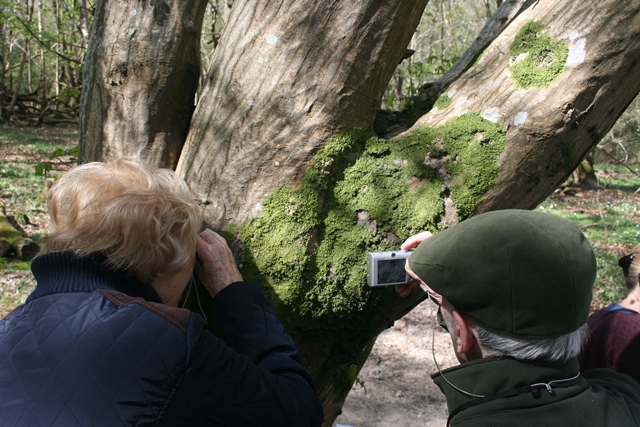
During our walk we found both Acrocarpus mosses such as Mnium hornum, with its leaves edged with a row of double teeth, and Pleurocarpous mosses such as Kindbergia praelonga, with its heart-shaped leaves on creeping stems and narrower leaves on its branches.
Amongst the liverworts we found leafy specimens such as Lophocolea heterophylla, with its delicate translucent shoots, and thalloid species such as Metzgeria furcata with its thick midrib and forking thalli.
It was altogether a most informative and enjoyable event.
Dr David Ware CBiol FSB
Plants for Bugs
25 March 2015
On a cool but dry Wednesday in March, 22 members visited RHS Wisley to hear about an ambitious project to investigate the effects that different mixtures of native and non-native plant species have on the fauna to be found in the garden.
This is important as we know that, excluding lawns, the average UK garden contains 70% non-native plants.
To investigate this question Helen Bostock, Dr Andrew Salisbury and the Plants for Bugs team set up 36 plots with a mixture of 14 species of plants including bulbs, perennials, shrubs, grasses or ferns and climbers, native to one of three geographic zones: Britain (Native), the Northern Hemisphere excluding UK (Near-Native) or the Southern Hemisphere (Exotic). These plots were then monitored for invertebrates using four different methods: pitfall and gastropod traps, a Vortis suction sampler and visual observation of visitors to the flowers.
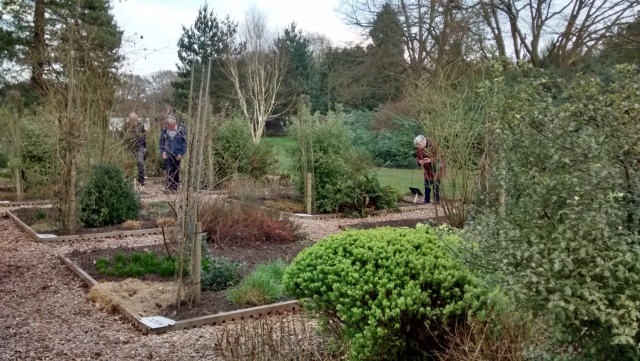
The data from these measurements are now being analysed and the first results on pollinator behaviour should appear shortly in the Journal of Applied Ecology.
For example results have suggested that honey bees tend to favour Native or Near-Native plants whereas long-tongued bumble bees and solitary bees showed no preference as to region of plant origin. However for gardeners who wish to support a wide range of pollinating insect species it is clear that the more flowering plants a garden can offer throughout the year, from different regions, the greater the number of bees, hoverflies and other pollinating insects it will attract.
For those interested in gardening in an insect-friendly manner the RHS has produced a list of recommended plants on its website.
A most interesting visit; I'm sure that many of us will be following with great interest the publication of further results and conclusions.
Dr David Ware CBiol FSB
Pandemic Viruses
11 March 2015
The Pirbright Institute, formally the Institute for Animal Health, has a unique role in this country and an international reputation as a centre for the control, containment and, where possible, elimination of viral diseases of animals.
Professor Fazakerley described, with many examples, the severe negative impacts that dangerous and potentially pandemic viruses can have on the health of livestock, on food availability and on the prosperity of farmers and other communities. He started his talk with an account of the emergence and spread of Ebola in West Africa. This virus, which first came to the attention of the scientific community in 1976, has now infected at least 22,000 people.
Other devastating diseases that he discussed included Foot and Mouth which, in 2001, caused losses to the economy of around eight billion pounds, and the H5N1 influenza virus, a cause of a highly infectious disease in birds which, if spread to intensively farmed chickens, is capable of causing severe economic damage.
H5N1 will also occasionally infect human cells causing a respiratory disease with a mortality rate of at least 50%. Other diseases discussed included African Swine fever, a devastating haemorrhagic fever of pigs with mortality rates approaching 100 per cent, and West Nile fever which can cause encephalitis in horses and humans and is now recognised as a major public heath concern in the US and Europe.
Many viruses therefore pose complex threats to human economies and human health and hence there is a need for centres such as Pirbright which can bring together scientists from a range of specialised fields such as virology, molecular biology, immunology, epidemiology and entomology and provide them with the high bio-containment facilities required for their work.
A most interesting and informative lecture.
Dr David Ware CBiol FSB
Mammals in Hargate Forest
29 October 2014
On a typically dull autumn morning in Tunbridge Wells members and guests assembled for coffee and biscuits prior to a talk by Sandy Williamson, the Woodland Trust Warden. Sandy explained how the Trust was set up, the current management plans, and the monitoring of a number of sites, including restoration and preservation of ancient woodland (PAWS) and their wildlife. She summarized the groups of mammals found in British woodland, estimating the numbers of each in turn as indicators of resources and environmental balance.
The current woodland distribution of species was compared with those of 10,000 years ago, with reference to those mammals suffering extinction from then until historical times, which included woolly mammoths, woolly rhinoceros, cave lions, lemmings, wolverine, elk, auroch, lynx, brown bear, wolf, beaver and wild boar.
These extinctions were caused, directly or indirectly, by human activity, and the aim of the Trust is to help those remaining to survive and prosper. Even such a simple expedient as leaving gaps between gardens to allow hedgehogs to increase their foraging range is beneficial to the species. Also, it is important to control introduced mammals, such as fallow and sika deer, grey squirrels, mink, and feral pets.
The practical part of the exercise was to identify and record small rodents caught in humane traps hidden strategically in various parts of Hargate Forest. So we emerged from the lecture into fine drizzle, which persisted throughout our tour. In spite of the conditions, we buzzed with anticipation each time we approached a trap concealed beneath the undergrowth, which invariably contained an occupant, albeit a woodmouse. Eventually, one of the dormouse nest boxes yielded a sleepy tenant. Well satisfied with the day's discoveries, we wound our happy way home through the gathering mist.
Dr Graham Godfrey CBiol FSB, Deputy Chairman KSS Branch
Fungal Foray, Chantry Wood
12 October 2014
Twenty-five members and friends assembled in the Chantry car park on a mild and pleasant morning for our annual outing with the intrepid Professor Maurice Moss. Chantry, maintained by the Woodland Trust, is a 200 acre site of mixed woodland and meadow a short distance from Guildford town centre.
During the morning's foray we identified around 40 species (download a full species list), ranging from a 23 inch diameter artist's fungus (Ganoderma applanatum) growing on a fallen beech, to the tiny pinhead stromata of the coral spot fungus (Nectria cinnabarina) on dead and dying twigs. We found two species of Mycena: M. vitalis, the snapping bonnet, characterised by the sound produced when the stipe breaks on pulling lengthwise, and M. galopus, the milky bonnet, whose white juice contains benzopyrenes, thought to assist in wound-activated chemical defence against yeasts and parasitic fungi. Parasitism among macrofungi was illustrated by the parasitic bolete Pseudoboletus parasiticus we found growing on the common earth ball, Scleroderma citrinum.
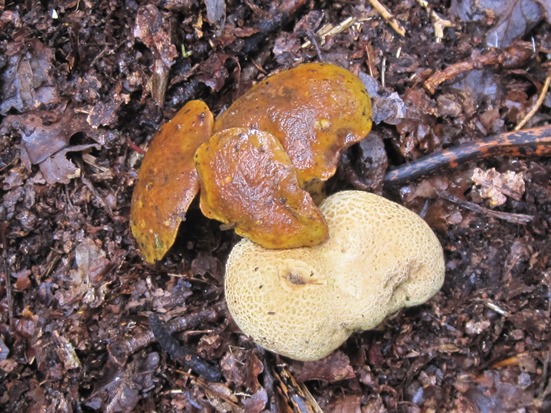
Two more of our finds illustrated the use of fungi in the treatment of cancer, such as the bitter bolete, Tylopilus felleus, whose extract contains the anti-tumour compound, tilopilan. Extracts of the stinkhorn (Phallus impudica) have been found to reduce platelet aggregation in the treatment of venous thrombosis in supportive preventative nutrition in breast cancer patients.
To end the day's entertainment, we were treated to a view of a clump of porcelain fungi, Oudemansiella mucida, with its translucent caps showing against the light high up on a beech branch, its usual location. Often in late autumn these fungi are dislodged by breezes and parachute down, although we were not privileged on this occasion to observe this phenomenon.
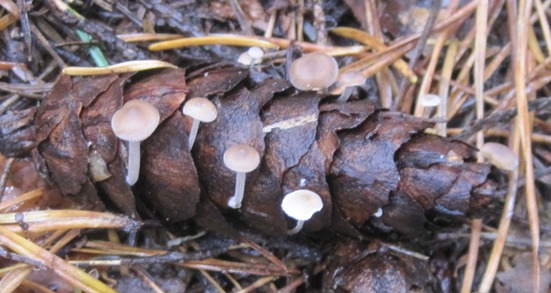
A species list is available to download.
Dr Graham Godfrey CBiol FSB
The butterflies of Denbies Common
16 August 2014
The lace border moth, Scopula ornate, is a rare and attractive chalk grassland species, the range of which is reducing. It is now only found in the south east of England and one site in West Norfolk. We were therefore most privileged to find one specimen during our walk on Denbies Hillside, Dorking.
Our walk was led by Malcolm Bridge from Butterfly Conservation and was enjoyed by some 17 members, relatives and friends.
Amongst the other species found on the hillside were speckled woods, small heaths, a gatekeeper, a brown argus, a common blue and some chalkhill blues. The distribution of this latter species follows the distribution of horseshoe vetch which, in turn, follows the distribution of chalk and limestone grassland. It is therefore normally restricted to the south of England.
However the most spectacular of the butterflies found was perhaps the adonis blue, also found on short turf. The larvae of the adonis blue are attended by ants, most commonly red ants, attracted by secretions from special 'honey glands' on the larvae. The ants then protect the larvae from predators.
Our guide also talked about the tentative identification of leaf miners from their burrowing patterns on leaves. These leaf miners are the larvae of insects, mostly moths and sawflies, which lay their eggs into the tissues of leaves where they bore through the softer leaf tissue.
The precise pattern formed by the feeding tunnel is diagnostic, often to genus level. For example our attention was drawn to the larva of the moth Stigmella tityrella, the mine of which, normally on beech, consists of a corridor that does not widen much but zigzags between two lateral veins in the direction of the leaf margin.
Dr David Ware CBiol FSB
Sampling the rock pools at Ovingdean
6 August 2014
Led by local expert Steven Savage, 18 members, friends and relatives spent an interesting afternoon investigating the flora and fauna of the beaches at Ovingdean, near Brighton, Sussex.
We arrived as the tide was receding and after an introductory talk by our guide, we were let loose on rocks made slippery with a covering of bladder wrack and serrated wrack, with some small amounts of ulva lactuca and Enteromorpha sp.
Close to shore, there was a small amount of the invasive brown seaweed, Sargassum muticum, originally from Japan, that can form extensive growths in very sheltered situations and even pose a hazard for the propellers of boats.
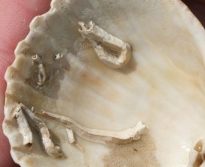 Digging beneath the sea weed we found limpets, barnacles, various species of periwinkle, common whelks and the occasional dog whelk.
Digging beneath the sea weed we found limpets, barnacles, various species of periwinkle, common whelks and the occasional dog whelk.
Also in the ponds and creeks were small hermit and common shore crabs, and a porcelain crab - not a true crab but related to the squat lobsters. It is distinguished from true crabs by its habit of walking on just three rather than four pairs of legs; the fourth pair being reduced and held against the carapace.
At the beginning of the event, our guide had handed out plastic beakers into which we could place our finds and, at the end of the event, Steven talked us through our findings, adding many interesting details about the creatures found.
Dr David Ware CBiol FSB
The flora and fauna of Howell Hill
7 June 2014
On a hot Derby day in June, 20 members set out to explore the rich nature of Howell Hill, a five hectare site formed of chalk spoil heaps from local civil engineering projects. It has subsequently been colonised by some 260 species of plants, thriving in nutrient-poor chalk soil.
The site has since been managed by Surrey Wildlife Trust to maintain the range of habitats and the rich flora and the visit was led by Peter Wakeham, secretary for the Surrey Botanical Society.
Of special note, we identified seven species of orchid, including the chalk fragrent (Gymnadenia conopsea) with its evening scent; the twayblade (Neottia ovata) with its basal pair of un-stalked, opposite leaves; the common spotted (Dactylorhiza fuchsii); the yellow man orchid (Orchis anthropophora); and the fascinating bee orchid (Ophrys apifera).
On the grass banks we found tall broomrape (Orobanche elatior), parasitic on greater knapweed (Centaurea scabiosa), and large areas of yellow rattle (Rhinanthus minor), a hemi-parasite on the roots of grass.
In addition to these plants, Howell Hill is also important as a site for the smallest butterfly in Europe; the scarce and declining small blue (Cupido minimus), of which we saw a number of specimens. This butterfly lays its eggs on kidney vetch (Anthyllis vulneraria), the growth of which on the reserve is being encouraged by the preparation of chalky scrapes.
Another interesting plant-insect interaction was pointed out as we were examining a black poplar near the entrance to the reserve. This tree has over 100 insects associated with it, including the hornet moth, wood leopard moth and the poplar hawk moth, and frequently has twisted galls on its petioles caused by the aphid Pemphigus spyrothecae. A very enjoyable and informative walk.
Dr David Ware CBiol FSB
Novel Approaches in Prostate Cancer
27 March 2014
Every year in the UK there are around 35,000 new cases of prostate cancer with some 10,000 deaths, however more men die with this cancer than from it, as not all cancers are aggressively malignant.
Dr Richard Morgan informed us that even with malignant tumours, early diagnosis can greatly aid survival. The standard test at the moment is for prostate-specific antigen (PSA) which is secreted from the tumour into the blood. In a recent study 76,893 men were followed, with half screened over six years and the other half unscreened. In the screened half more cancers were detected but there was no improvement in survival. This suggests that widespread screening would not be cost-effective, presumably as the PSA test does not distinguish effectively between aggressive and non-aggressive tumours.
He then discussed the possible role of embryonic genes, especially HOX and Engrailed genes, in cancer. In humans HOX genes are a group of 39 genes, the protein products of which are transcription factors which activate or repress genes controlling the formation of tissues, structures and organs within the foetus. These HOX genes also become activated in prostate tumour cells and there stimulate uncontrolled growth.
Dr Morgan has been working on HOX proteins and other transcription factors which act in embryonic-development and which are potential targets and biomarkers in cancer. Preliminary work has indicated that Engrailed-2 (EN2) levels in the urine of men with prostate cancer roughly correlate with tumour volume, which in turn is an indication of tumour aggressiveness, and that the test is twice as sensitive as the standard PSA test.
Dr Morgan's work has also produced a range of reagents that block HOX function and which have proved to be potent anti-cancer molecules, at least in mice; a most interesting and informative lecture.
Dr David Ware CBiol FSB
Plant Fascination
18 December 2013
Wakehurst Place has been described as Kew in the Country, with its 465 acres of ornamental gardens and temperate woodlands it affords some spectacular walks. It was made more interesting by the knowledge and enthusiasm of our guides, Beth Thorold and Jim Heath.
As expected In December there were few flowers to brighten the landscape yet the gardens could still boast a range of architectural trees like the Scarlet Oak (Quercus coccinea) with its bright red autumn foliage or Farges's Holly (Ilex fargesii) with its dark green leaves.
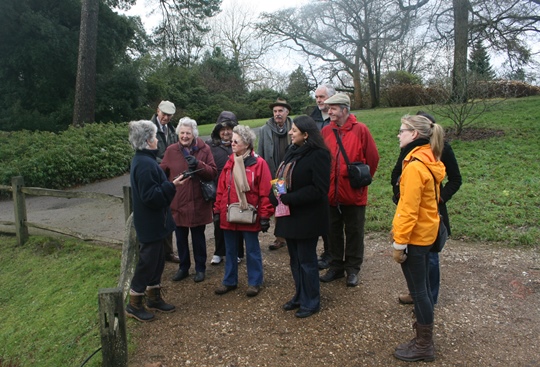 Laboratory manager Keith Manger MSB and Drs Louise Colville and Rosemary Newton conducted tours of the millennium seed bank. We were talked through the process by which seeds from some 154 countries and 24,000 different species, including from virtually all the UK's native plants, have been collected and preserved.
Laboratory manager Keith Manger MSB and Drs Louise Colville and Rosemary Newton conducted tours of the millennium seed bank. We were talked through the process by which seeds from some 154 countries and 24,000 different species, including from virtually all the UK's native plants, have been collected and preserved.
Much of this collecting is by local specialists who know the plants in their area and can collect not only seeds but also vegetative specimens including flowers so that their identity can be confirmed. The seeds are then dried, cleaned, allocated a collection number, then stored in hermetically sealed glass bottles, or in tri-laminated foil bags, at -20 degrees or at liquid nitrogen temperatures.
But the seed bank is not only a collection of world-wide importance it is also a research facility with some 20 scientists confronting vital problems such as the breaking of seed dormancy, the storage of the most delicate and recalcitrant seeds, and the biochemical changes associated with the death of seeds from environmental stress.
A fascinating and extremely informative visit.
Dr David Ware CBiol FSB
Genomics of smell
16 October 2013
The sense of smell in humans involves a large family of around 1000 olfactory receptor genes, yet most humans are able to detect an even greater number of odours, thought to be over 10,000.
These and many other interesting points were made by Drs Natasha Hill and Juliet Dukes from Kingston University in their lecture to members and students at Sutton High School for Girls.
Dr Hill explained the physiology of odour detection, from the structure of the membrane-bound receptors to the initiation of an action potential as the aroma molecule binds and stimulates membrane depolarisation. This process is exceptional in that it represents the only sensory system that projects directly into the brain.
She reported that sensitivity to odours differed between individuals and tends to decline with age. It also differs between males and females and in many animals plays a role in mating behaviour. However in humans this role may be overridden by learnt behaviour. Drs Hill and Dukes went on to conduct an experiment to measure the sensitivity of some students to different smells.
Dr Dukes discussed some evolutionary aspects of the sense of smell from fish, through amphibians to reptiles and then mammals. The sense of smell progressively declined in higher mammals that preferentially used sight as their major sense.
We are able to use this sense in animals, for example using dogs to detect contraband, land mines, disease etc. A cheaper alternative could be to use rats or even insects as these had equally good senses of smell but were quicker to train. Dr Dukes concluded the evening with an overview of the current state-of-the-art of genomics technology with examples of its uses.
Dr David Ware CBiol FSB
Sampling the beers
4 September 2013
Since its inception in 1992, Hogs Back Brewery has won over 40 awards for its beers with, in 2006, its Traditional English Ale being voted by CAMRA 'best beer' and its Aromas over Tongham (A over T) beer voted as Supreme Champion Winter Ale.
This small brewery uses techniques very similar to those of traditional craft brewers and produces over 7,000 gallons of real ale per week. That is to say that the fermentable sugars are derived only from malted barley, the hops used are local whole hop flowers, the yeast strain is carefully maintained and reused, and, at the end of the fermentation, the beer is cask or brewery conditioning. For example the most popular brand, Traditional English Ale, that was once conditioned in the bottle is now brewery conditioned and bottled under nitrogen to give a sparkling beer and a prolonged shelf life.
Noel Armstrong entertained us with his detailed knowledge and enthusiasm for the brewery's products and by the provision of a succession of jugs of beer and cider. Following this tour, we were privileged to have chief brewer Miles Chesterman answer our more scientific questions on the art and science of brewing. Our group were particularly interested in how, over the years, the brewery has been able to maintain the individual taste and quality of its different beers.
Overall, a most interesting and informative event and, for all interested in real ale, a strongly recommended visit.
Dr David Ware CBiol FSB
Experiencing Wakehurst
31 July 2013
Stalwart members braced the rain for a tour of Wakehurst gardens and the Millennium Seed Bank. Jim Heath MSB was our very knowledgeable guide, he pointed out and discussed many of the rare and interesting specimens.
The Franklin tree, Franklinia alatamaho, has been extinct in the wild since the early 19th century and is the sole surviving member of its genus. We also admired the beautiful blue Hydrangea macrophylla, the Daimyo oak, Quercus dentate, with its leaves up to 30cm in length, and many, many other fascinating specimens.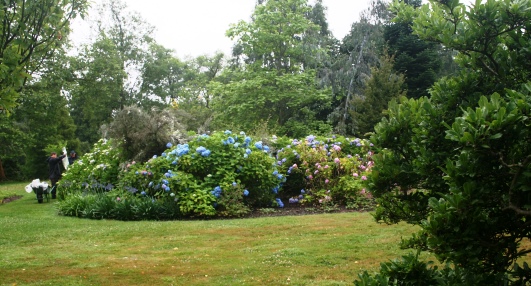
From the gardens we were then led to the Millennium Seed Bank where we were privileged to be shown around by two of the senior scientists, Keith Manger MSB, the laboratory manager and Professor Hugh Pritchard FSB, the head of research. As we toured the laboratories, dry rooms, cold rooms and other facilities we were talked through the process by which seeds from some 154 countries and 24,000 different species, including from virtually all the UK's native plants, have been collected and preserved.
On arrival at the bank the seeds are dried, cleaned (by separation from dust and fungal spores), then examined by techniques that include digital x-raying, a process that enables the rapid recognition, then removal, of any insect infested, immature, diseased or malformed seeds. The seeds are then identified, allocated a collection number, then stored in hermetically sealed glass bottles, or in tri-laminated foil bags, at -20 degrees or at liquid nitrogen temperatures. They are then available for research, for example by the bank's team of some 80 scientists, or for repopulation of their original habitat; a fascinating and extremely informative visit.
Dr David Ware CBiol FSB
Scouring for macrofungi
11 November 2012
 Professor Maurice Moss led 30 members and guests in search for fungi amongst the autumn leaves in Sheepleas, Surrey.
Professor Maurice Moss led 30 members and guests in search for fungi amongst the autumn leaves in Sheepleas, Surrey.
Amongst the 35 species identified was a range of wood rotting species such as Piptoporus betulinus, the razor-strop fungus, and Ganoderma applanatum, the Artist's Bracket, so named because when the lower surface is scratched it changes from light to dark brown, producing clear lines. Another common polypore was Trametes versicolor, the turkey tail fungus, named for the white to brown bands on the upper surface of its fruiting body. We also found, on an old tree stump, the small conical agaric, Mycena haematopus, the bleeding fairy helmet, which when cut exudes a red dye which stained the finger on one of our members.
We come across the edible Hypholoma capnoides, distinguished from the more common, but poisonous sulphur-tuft (Hypholoma fasciculare) by its greyish-gills and the dark colour of its spores. Both are found on the stumps of deciduous trees. Amongst the beech leaves we found the Magpie fungus, Coprinus picaceus, which is possibly poisonous and certainly unpleasant as it is reported to produce the volatile indole, skatole, found in human faeces.
There was also Lepiota procera, the parasol mushroom, favoured as a delicacy, and the slimy milk-cap, Lactarius blennius, with its pale olive/ greenish grey convex cap. This latter fungus is known to contain a number of pharmacologically active compounds including the anti-inflammatory 'blennin A'.
Dr David Ware CBiol FSB



